Lesley Ann McDaniel
Real Life~Pure Fiction

How to Write a Nonfiction Book Review
May 13, 2013
Do you love reading nonfiction books? Why not try your hand at reviewing them.

What is a nonfiction book review?
A book review is a critical evaluation of a book. It isn’t just a summary, but gives commentary that will be uniquely yours as the writer of the review. The difference between a review of fiction versus nonfiction is that with the latter, the reviewer will evaluate the piece not so much on its entertainment value as on whether it fulfills its promise to solve a particular problem or deliver certain information.
Why write book reviews?
Reviews help books get noticed and gain credibility. Writers want to receive reviews to show readers that their book is widely-read and well-received.
Where are reviews posted?
These days, the answer is ‘lots of places.’ Many reviewers post book reviews on their own blogs. You can also post reviews on Amazon, Goodreads, library websites, or submit them to other people’s review blogs. If you really want to get serious, there are a lot of literary journals that accept freelance reviews.
How long should a review be?
That will depend largely on where you are planning to submit your review. Check for guidelines, and assume that you will write anywhere from 100 to 1500 words. Be succinct, but give enough to serve the purpose of the review.
Points to Consider:
●What if you really don’t like the book? Always write your reviews with integrity. If you honestly don’t like a book, write your review as if you are in a critique session with the author. Use positive words and avoid sarcasm.
●Take time to read reviews written by other readers, but keep in mind that many of them are not trained reviewers.
●Review the book that has been written, not the book you think the author should have written. It isn’t fair to criticize an author for failing to achieve something he or she never intended to achieve.
Nonfiction Book Review Template:
Opening statement: Include title and author.
What does the book promise to deliver to the reader? Another way to look at it is, what problem does this book promise to solve?
Does it accomplish what it sets out to accomplish?
If so, how?
If not, what could the author have done differently?
What makes this author uniquely qualified to write on this topic?
What is the tone of the book? Is it humorous and easy to relate to, or is it more dry and academic?
Overall impression: This is where you give your personal take on the book.
Suggested points to include:
Was the book written in a way that you as a reader could easily relate to?
What was your favorite part of the book?
Do you have a least favorite part of the book?
If you could change something, what would it be?
Are there photos or illustrations? If so, are they effective in enhancing the book’s message?
Would you recommend this book?
What type of reader would enjoy this book?
There are so many wonderful nonfiction books out there. Have a great time reading and reviewing!
Have you written any nonfiction book reviews?
If you enjoyed this post, you might also enjoy How to Write a Fiction Book Review .
Tweetables:
Want to write great nonfiction book reviews? It’s easier than you might think. Click to Tweet!
How to write a nonfiction book review. It’s easier than you might think. Click to Tweet!
Help nonfiction authors promote their books; write reviews! Click to Tweet!
Help readers find great nonfiction books; write reviews! Click to Tweet!
Share this:
- Click to share on Twitter (Opens in new window)
- Click to share on Facebook (Opens in new window)
- Click to share on Pinterest (Opens in new window)
- Click to email a link to a friend (Opens in new window)
May 20, 2013 at 1:19 pm
Thanks for some more helpful tips on writing book reviews Lesley.
October 16, 2020 at 12:01 pm
I am writing a review for a friend of my son who has a book on how to begin a blog. I thought the reminder you offered about illustrations was something I did not think about. The obvious alludes us sometimes.
December 29, 2014 at 12:25 pm
Very helpful, Lesly. I printed this out! Amy
December 30, 2014 at 10:27 am
Amy, I’m so glad you found the post helpful. Reviews are so important to the success of a book.
September 26, 2020 at 9:31 am
I am writing creative nonfiction book, how do I get contacts for reviewers of my book?
September 26, 2020 at 10:46 am
There are lots of ways to find reviewers. I’m not an expert on that, but if you google “how to get reviewers for your book,” you should find lots of ideas.
June 16, 2020 at 6:03 am
Thanks so much, Lesley for providing this information.!
June 16, 2020 at 7:13 am
My pleasure, Vicki. I’m glad you found it useful.
October 9, 2020 at 10:46 am
Lesley Thank you for a concise yet thorough piece on book reviews. I learned much. Best to you and yours.
October 9, 2020 at 10:56 am
I’m glad it was helpful for you, Jim.
November 8, 2020 at 9:43 am
This was really helpful. I’ve never done a non-fiction book review before, so I learnt a lot from this. Thank you!
November 8, 2020 at 11:34 am
I’m so glad it was helpful.
November 25, 2020 at 9:23 am
I’m writing a nonfiction book review for a class project. How do i make the review interesting and engaging?
November 25, 2020 at 9:48 am
What a fun class project! My best advice is to read examples of nonfiction reviews and pick out the ones that are interesting to you. What is it about those reviews that makes them stand out? Also, let your own voice and style shine through in your writing. Hope you get an A+!
May 10, 2022 at 11:34 pm
I read a lot of non fiction books and now have decided to start documenting my reviews..
Do you recommend I set up my own blog. I would prefer to do it on a platform that is popular.. That even the authors might pay a visit.
But I also want to include a summary of key points in the book. This way I can go back to the summary ant remind myself what the book was about
June 24, 2022 at 5:33 pm
I think setting up your own blog is a fantastic idea. Best to you!
[…] How to Write a Nonfiction Book Review. […]
Leave a Reply Cancel reply
Your email address will not be published. Required fields are marked *
Notify me of follow-up comments by email.
Notify me of new posts by email.
This site uses Akismet to reduce spam. Learn how your comment data is processed .


She Seeks Nonfiction
A skeptic's quest for books, science, & humanism

How to Write a Nonfiction Book Review
Next week, I will be writing my 50th nonfiction book review on this blog. Learning brings me great joy, and when I learn fascinating things in my books, I can’t help but share them with you!
With Nonfiction November coming up, I know that many fiction book bloggers will try their hand at reading and reviewing nonfiction, and that many people aren’t used to it. There is often no character development, plot, setting, or allegory to critique, so what is left? Well, there is actually a lot to talk about, and I think reviewing nonfiction books is a lot of fun! I hope that through this post, my passion for writing nonfiction book reviews can inspire the unsure to give it a try.
There is not one correct way to write a book review. I write mine for fun, as a way to make blog posts that entertain me and hopefully my audience. Reviews make reading more fun and they help me to better engage as I read. They can even make it more bearable to finish a book I hate, because I know that my review will be interesting ! Regardless, here are some tips that help me write book reviews that I am proud of.
Mark up your book
I’ll start off with the obvious: I think that underlining and taking notes in nonfiction books is a great way to remember what you read and get ideas for your review as you go. My husband is adamant that my constant marking up of brand new books makes me a crazy person, and I can’t blame him for that. Some people can’t stand it.
If this is you— or if you read library books —then don’t worry! You can still use sticky notes or keep a separate notebook handy. I actually do this when I read books that are so old I would not dare deface them. Of course, e-readers make this easy; you can highlight and add notes without vandalizing anything. Finally, I know that a lot of people like to listen to nonfiction audiobooks, but I can’t imagine that you would absorb the information enough to make a review that way. But hey, if you can, more power to you!

Answer these three questions
I believe that each review will be as different as each book is, but there are a few questions that I attempt to answer no matter what.
Does it accomplish its goal?
First, I critique it according to its own criteria. Does the title promise that the book will deliver something specific? Is it meant to persuade you or inform you, and if so, how does it do? If a book’s title starts with “How to,” then you know exactly what the goal is. For example, How to Be an Antiracist by Ibram X. Kendi did exactly that; Kendi repeatedly began sentences with, “To be an antiracist is to…” which is about as straightforward as it gets. On the other hand, How to Argue With a Racist by Adam Rutherford might sound like it gives responses to specific points you’d hear in an argument, but it doesn’t. (It was still a great book though!)
(Now that I’m on the topic, Let the People Pick the President: The Case for Abolishing the Electoral College by Jesse Wegman does give line-by-line responses for arguments, which I thought was a great approach.)
There are more ways that a book can express its goal. Maybe the introduction lays out why the book exists at all. This is one thing I really appreciate about Richard Dawkins’ books. My feelings about the book as a whole are mixed (and my feelings about Dawkins as a person are lacking), but in the preface of The God Delusion , Dawkins lists out exactly how he is going to make his case for atheism. He promises to meet different readers where they are. “Do you believe X? Well, I explain this exact thing in Chapter X.” The man knows how to make a promise. Obviously, a preface does not need to be this explicit to make a book good, but it definitely made my review easier. This was especially great for me, as The God Delusion was only the second book I ever reviewed.
Do I like it?
Even though Adam Rutherford’s How to Argue With a Racist did not teach me how to argue with a racist, I still gave it a rave review. That’s because the second question I set out to answer is a simple one: Did I like the book? I’m the one writing the review, so I decide whether it’s a positive or negative one. This is when book reviews get really subjective, and why I love when there are many of the same book. No two people will have the same exact opinions about it. Many times, I have admitted that a book was probably good , but that I don’t think I was the right audience for it.
Does it speak to a target audience?
This brings me to the third question: do you know the book’s target audience? If there is no clear audience, then there’s a good chance the whole book is moot. Take this post, for instance. My intended audience is primarily fiction book bloggers who are trying out nonfiction book reviews for November. Hopefully other people will find something useful or entertaining out of it, but if you don’t care about books or reviews or blogging at all, then this post probably isn’t for you.
Decide whether you want to stick to a formula
If you have never written a nonfiction book review before, it can be easier to follow a formula and always know what you want to include in your review. A great example of this is fellow nonfiction book blogger Paula Ghete ‘s book reviews such as this one of Cosmos by Carl Sagan ( which you can compare to mine to see how greatly our styles vary). Her book reviews are structured this way:
Title: Cosmos Author: Carl Sagan Category: Non-fiction, Science Rating: 5/5 10-Word Summary: We can understand the Universe only if we study it. About Cosmos [short summary] What I like about Cosmos [list with bullet points and descriptions] What I don’t like about Cosmos [list with bullet points and descriptions]
In other book reviews, such as this one , Paula also included the following sections:
Quotes from The Idiot Brain [lists eight relatively short quotes] Should You Read The Idiot Brain? [succinct, defined answer]
Admittedly, her reviews are clearly written with SEO and readability in mind. Search engines love to say, “The more headlines and the shorter the sections, the merrier,” so that they know what the post is about. This also helps the reader to get Paula’s big ideas even if they don’t wade through the – gasp – paragraphs !
On the other hand, my review of Cosmos described how it left me speechless, why it was virtually unreviewable, why it made me almost cry watching the launch of NASA’s Perseverance, and why Sagan is so beloved in the atheist community .
Something fun about me is that I pretty much write whatever I feel like writing, which might make you think that I would not be the most qualified to tell you how you should write your own book reviews, but there I go again, writing whatever I feel like which includes this review-tutorial. Look, I’m just here for a good time.
How my own book reviews take shape
As I said earlier, each review can be as different as each book. This is more true for someone like me than for someone who is a little more organized like Paula Ghete, because I don’t really abide by any restraints. I don’t write only book reviews, so if a review takes me to another topic that I care about anyways, I’ll just talk about that. I love when a book simply inspires me to share what I’ve learned from it, or gives me the opportunity to ponder something I wouldn’t have thought of if I hadn’t read it.
The Gnostic Gospels by Elaine Pagels was a pretty informative book about—you guessed it—the Gnostic Gospels and Gnostic Christianity. I honestly didn’t have much to say about the book itself, but it caused me to compare early Gnostic Christianity to modern-day Progressive Christianity, list the similarities and differences, and pose the question to my Progressive Christian audience what they think of it.
My review of The Power Worshippers: Inside the Dangerous Rise of Religious Nationalism by Katherine Stewart had a similar fate. An actual review of the book was definitely present throughout my post on it, but it was a great chance for me to delve into my own experiences learning about Christian Nationalism , inside and outside of Stewart’s book. I also found myself comparing The Power Worshippers to Andrew Seidel’s The Founding Myth: Why Christian Nationalism is Un-American and explaining why the two books complement each other.
When I’ve read two or more books by the same author or on the same subject, I love to compare and contrast them or explain how they go together. I’ve done that with these, as well as books by Ibram X. Kendi , Ian Tattersall , Carl Sagan , and the two most famous works in the atheist community .
Final thoughts
As is the case with many of my book reviews, there is a lot more I could say. And like those, I often have to stop myself from rambling on ad nauseum . When this happens with a review , I have to just give the big idea, some fun facts, and then tell my audience that you really ought to read it for yourself. So I’ll do that here. I hope that my advice has helped you to see nonfiction reviews as a little less scary, and I encourage you to try writing them yourself! I’m so excited to read them!
Share this:
- Click to share on Twitter (Opens in new window)
- Click to share on Facebook (Opens in new window)
- Click to share on Reddit (Opens in new window)
- Click to share on Tumblr (Opens in new window)
- Click to share on Pinterest (Opens in new window)
- Click to email a link to a friend (Opens in new window)
You may also like
13 thoughts on “ how to write a nonfiction book review ”.
Great post! It was very interesting for me to read how you go about structuring and writing your non-fiction reviews. I also reviewed around 60 non-fiction books and I think I need to incorporate more headings and keep my paragraphs shorter. I have to say that I find reviewing non-fiction so much easier than fiction. Maybe because I can talk about real facts behind the author’s writing because it is sometimes difficult to guess ideas behind all the creativity and imagination of a fiction author. I love reviewing history, history of science and travel in particular.
Thanks! And history of science is one of my favorites too!
I wrote my first book review recently and found that I learned as much in writing the review as I did reading the book. Writing book reviews is fun.
I will often finish a book feeling one way about it, but after reviewing it and articulating my thoughts, I will feel an entirely new way about it. Sometimes it is to the extent that I have to change my Goodreads star rating after writing my review because I saw the book in a whole new way!
In my opinion, this is a useful post for any book review. I don’t write many, but I read mostly non-fiction. I plan to facilitate a Zoom book review group next Saturday (fiction and non-fiction). Your advice should be helpful for me to coax readers to explain more about the books they read. Suggestions are welcome. 🙂
That sounds so fun, good luck!
🙂 Thank you, Rebekah.
Absolutely brilliant post. Thanks for sharing!
Pingback: Links Nonfiction November #theOCBookGirl #nonficnov #nonfictionbookparty - The OC BookGirl
I’m delighted to have discovered your blog via #NonficNov, and appreciate you sharing your thoughts here. I’m going to be browsing around a while 🙂
Yay! I hope you love it! 😊
Thankyou for this article. I am really obsessed with the book Three Brothers from Virginia these days and I think the author Andy Lazris really has a gift to keep people interested in topics that are too boring.
What do you think? Cancel reply

Ann Kroeker, Writing Coach
December 11, 2020 5 Comments
How to Structure Your Nonfiction Book

You’re tackling a non-fiction book and you’re making progress. You’re doing research, you’re writing, and now you’re staring at all those ideas.
Your book needs form. It needs organization. It needs…structure.
But how do you land on the best structure? How do you create it, craft it, build it?
While there’s no one standard way to organize your material—there’s no one way to structure your nonfiction book—I offer four approaches you can take to determine what will work best for your work in progress.
To learn ways to structure your nonfiction book, you can read, watch, or listen.
Think about how different kinds of bridges are needed for different situations. To land on the best method of bridging a ravine or body of water, an engineer will study the surrounding landscape and obstacles to decide whether a drawbridge, suspension bridge, or arch bridge will work best.
Just as an engineer needs to study the situation to address any given crossing and can refer to several core types of bridges, you get to do the same with your book.
As you study your material, you get to decide the best way to structure your nonfiction book.
Feel free to apply these four approaches to structure your short-form writing, but I’m going to be talking about it as it pertains to a non-fiction book, because a book is more unwieldy and can feel a little overwhelming to organize. Once you get a handle on how to structure your WIP, you can feel more confident moving forward with your draft.
If you’re feeling overwhelmed by structure, you’re in good company. In a Writer’s Digest interview, Michael Lewis said this:
I agonize over structure. I’m never completely sure I got it right. Whether you sell the reader on turning the page is often driven by the structure. Every time I finish a book, I have this feeling that, Oh, I’ve done this before. So it’s going to be easier next time. And every time it’s not easier. Each time is like the first time in some odd way, because it is so different .1
The book you’re working on now is different from any other book you’ve worked on. It’s different from Michael Lewis. It’s different from mine.
You need to discover the best structure for this book .
Method 1: Discovery
The first way is by discovery.
Through the discovery approach, you’re going to write your way into it.
On her podcast QWERTY, Marion Roach Smith recently interviewed Elizabeth Rosner about her book Survivor Caf é . Elizabeth Rosner chose different terms and concepts and horrors related to the Holocaust and presented them early on in the book using the alphabet.
The alphabet was a way of structuring that content.
Rosner said the alphabet was a way to explain, “Here are all the things I’m going to talk about that I don’t really know how to talk about. Here are all the words I don’t know how to explain.”
Marion asked how she arrived at this alphabet structure, and here’s what Rosner said:
I love getting to talk about structure and decisions. And when we talk about them after they’ve been made, it all seems so thoughtful and careful and deliberate and…everything in reality is so messy and chaotic for me, that it’s always amazing to me how neat and coherent it seems afterwards. 2
You can see that Rosner sort of stumbled on this approach. It serves as an alternative table of contents for the book, she said, and of course a table of contents reflects the structure of a book. And she came upon by discovery.
Discovery Methods: Sticky Notes, Scrivener, Index Cards, Freewriting
Authors might use Post-its to organize their notes.
Susan Orlean has described an index card method (she uses 5×7 cards) in an interview. 3
Others like using Scrivener to organize their research and notes.
It doesn’t really matter the method; you just need to gradually move toward clarity. When you stay open to possibilities, the structure often presents itself in the process of organizing and reorganizing notes and in the process of writing.
Through freewriting you might begin to land on a structure that will work for this book. Or by writing chapters or sections within chapters, a structure may naturally—organically—emerge.
You may see patterns, themes, words, concepts that suggest an approach, so keep your mind open and your eyes peeled to the possiblities.
Method 2: Determine Your Book’s Structure in Advance
The second way you can land on structuring your book is by determining it in advance.
Plotters and Pantsers
In fiction we talk about plotters and pantsers. Plotters are people who plot out their novel in advance and then follow that plot pretty closely while writing.
Pantsers are people who write by the seat of their pants—it’s that discovery method they’re approaching for writing their novel.
If we were to apply this idea of plotters and pantsers to nonfiction, the pantser would be writing by discovery. You’re flying by the seat of your pants, writing your way into the structure as you work on it, letting it unfold before you.
This is a perfectly acceptable way to go about structuring your book. Pantsers may find it’s less efficient than other methods, but it can yield really rich results because they’re letting the process guide and inform what they’re doing.
The plotter approach is more like this nonfiction approach of determining your structure in advance.
Structure with Outlines
If you choose this approach to structuring your WIP, you’re like a plotter determining in advance the outline that makes sense for the ideas.
And you do this in many different methods.
Nonlinear Option: Mind Maps
Some people—especially people who resist sequential, linear thinking—like to use the mind mapping or cluster approach. You may have seen this, where somebody writes a word or a key term in the center of a giant piece of paper or white board. The video shows it in action.
In the middle of that space, you write the key word or phrase that captures the big idea of your book. Underline or circle it, and let your mind think through all of the subtopics. The subtopics could potentially become chapters in the book or paragraphs of an essay, but because you’re using a cluster effect you aren’t restricted to a linear outline.
You’re letting your mind sort of just go in whatever direction it wants to go, capturing these ideas, each subtopic spreading out from the main idea with more spokes to represent ideas and details you know you want to include.
Linear Option: Outlines and Lists
You can go the traditional route with the Roman numerals I, II, III, IV, and A, B, C, i, ii, iii.
Or you can just make lists. For that you can use regular numbers or bullet points to get your ideas out.
Whether you use paper or a whiteboard, your end result will be more linear, but you can always reorganize to land on the best order.
Before You Write, Think and Plan
It doesn’t really matter how you go about it. Use scrap paper if you don’t have a whiteboard. Make a list with bullet points if the mind map looks weird to you.
The key is to think through your idea before you write.
Revisit the research you’re doing or have done and piece it together to decide on the topics you want to tackle in light of your major concept for this book.
Once you land on that structure, write to that structure, just as a plotter will write a novel following the plot determined in advance.

Method 3: Use a Classic Structure
The third approach you can take to structuring your book is to choose a classic structure.
By classic, I mean that there are classic outlines that have stood the test of time.
Let me give you a few examples.
Classic Structure 1: Problem-Cause-Solution
The first would be Problem-Cause-Solution .
You can drop the “cause” if you want to, though in a book you have space to address the cause of a problem so the reader can learn how to eliminate it. After that, you present the solution to the problem, and most of the content would cover the solution.
Problem-Cause-Solution is a fabulous classic structure to use for nonfiction projects. You’ll find it used in marketing tactics, where people are presenting the problem, addressing the cause, and then saying, “Here’s the solution with this clever product we’re offering!”
Classic Structure 2: Past-Present-Future
Another classic structure you could grab an attempt to organize your material is Past-Present-Future.
With this pre-fab structure you look back on the history of what brought us to a certain event or pattern in our culture, identify where we’re at right now, and suggest where we should be heading—and how we can begin moving in that direction.
Play around with these structures as much as you like to make them work for you: for example, why not start with the present, then look back at the past and end by looking to the future: Present-Past-Future.
Don’t feel locked in to the order; let it inspire creativity. Play with these to make them fit your project.
Classic Structure 3: Narrative
Another classic structure you can borrow is the narrative structure. With its beginning, middle, and end, you use story to organize your material.
Obviously a narrative arc is going to work really well for a biography or a memoir, but you can actually layer a narrative arc over ideas you want to present and let the story guide the order in which you present your ideas.
Method 4: Borrow (and Adapt) Another Structure
The fourth way you can structure your book is to borrow and adapt a structure you find in another book.
Study a Book’s Structure
If you read, watch, or listen to “ How to Read Like a Writer ,” you’ll learn various approaches to reading that can turn a text into a tutor. While you’re practicing those techniques, you can specifically study and analyze that book’s structure.
Pay attention to books in which the author easily and effortlessly conveyed information and ideas. When you find a project that’s especially effective at drawing you into the book and walking you through the material, figure out what worked. The table of contents is a great place to start. How did they organize their chapters?
Be careful not to plagiarize choices. If you copy an author’s unusual structure exactly, you’re no longer using it for inspiration. Yet there are a limited number of ways books can be organized, so study and be inspired.
Borrow from Other Genres
When you’re reading in a genre other than your own, pay attention—you may discover an idea to adapt and experiment with.
Let’s just say you come across a biography that organizes the subject’s life in seasons or months of the year. You would not have thought about that for your leadership book, but you realize it might work.
Adapt it. Borrow the structure and adapt it to fit your completely different project.
Maybe you won’t use months but that biography caused you to play with reordering your content around a four-part structure using Q1, Q2, Q3, and Q4, which could work great for a leadership book with readers who organize their business by quarterly goals.
And the structure no longer resembles the biography, which was organized by by seasons or months. Seeing the months inspired you to re-imagine how your content could flow using a completely new approach.
Borrow and adapt to avoid plagiarizing; find inspiration and adapt as needed.
Restructure at Any Point in the Creative Process
Whether you’re at the beginning of formulating your book’s concept or you’re halfway through and decide the structure is just not working, test these methods to organize or reorganize.
A complete restructuring will feel laborious but can be worth it when you land on one that allows your readers to grasp your concepts and be transformed.
Rather than just grabbing the first idea that comes to your mind, play around with these different kinds of structures to find the support you need to convey your ideas with clarity and confidence.
_____________________
Ready to elevate your writing craft—with a coach to guide you.

Get the direction you need to improve as a writer with The Art & Craft of Writing . In this eight-week intensive, I’ll help you elevate your writing skills and create a compelling piece you’ll be proud to show an editor or agent. By the end of our time together, you’ll have completed a 3,000-word piece, along with multiple short submissions that invite you to experiment and play with new techniques.
______________________________
Related Reading
- You may be ready for my comprehensive signature program —check out Your Compelling Book Proposal
- How to Read Like a Writer
- QWERTY interview with Elizabeth Rosner
- Writer’s Digest ‘s Michael Lewis interview
- Are Outlines a Writer’s Greatest Gift…or Curse? (more detail on the classic Past-Present-Future outline)
- Try This Classic Structure for Your Next Nonfiction Writing Project (more on the classic Problem-Cause-Solution outline)
- Susan Orlean on Pacing, Structure, and ‘The Library Book’ (Episode 121, The Creative Nonfiction Podcast)
- Cordell, Carten. “Immersive Nonfiction & Idea Generation with ‘The Fifth Risk’ Author Michael Lewis.” Writer’s Digest , Active Interest Media, 20 Nov. 2018, www.writersdigest.com/writing-articles/research-nonfiction-narratives-idea-generation-with-the-big-short-author-michael-lewis.
- Smith, Marion Roach. “Where We Get Writing Inspiration, with Writer and Author Elizabeth Rosner.” QWERTY | Memoir Coach and Author Marion Roach , 22 Aug. 2020, marionroach.com/2020/08/where-we-get-writing-inspiration-with-elizabeth-rosner/.
- O’Meara, Brendan. “Episode 121-Susan Orlean on Pacing, Structure, and ‘The Library Book’.” Episode 121-Susan Orlean on Pacing, Structure, and ‘The Library Book’ – Home of The Creative Nonfiction Podcast , 7 Apr. 2020, brendanomeara.com/orlean121/. Beginning at the 32:00 mark.

Note: This post content has been modified slightly from the audio transcript to tighten and clarify.
September 22, 2021 at 4:33 pm
Thank you for putting this out there. I agree with your opinion and I hope more people would come to agree with this as well.
Leave a Reply Cancel reply
Your email address will not be published. Required fields are marked *
Save my name, email, and website in this browser for the next time I comment.
Landing page graphic and other design elements by Sophie Kroeker .
- ghostwriter
- Self-Publishing Your Book: From Concept to Finish
- online course creator
- Free Brainstorming Session with Pat
How to Write a Non-Fiction Book Review
by Pat Iyer

Someone asks you to write a non-fiction book review. This first question you need to answer is:
Is This a Good Subject for You?
Consider the subject matter. Do you know anything about it? Whether you do or not, does it interest you?
These really are separate questions. You might, for example, know a lot about a subject that bores you. You’re not going to enjoy reading about it, and you’ll do the author no favors by agreeing.
If the subject interests you, knowledge of it will obviously help you to point out how the strengths of the book. Even if you’re unfamiliar with it, you can have the valuable perspective of many potential readers in your position.
Whatever your knowledge level is, you can comment on the organization, pace, and general interest of the book.
Do You Feel Qualified to Write a Non-Fiction Book review?
By this I mean do you feel that you have the ability to critique the book? (Clearly many reviewers are free to offer their opinions, sometimes about topics that they are not knowledgeable about.)
You may think, “I’ve never done this before, and I wouldn’t want to let the author down.” That may or may not be a valid reason to turn down the request.
Lack of experience isn’t in itself a reason not to agree. “There’s a first time for everything” is a cliché, but it’s still true.
Ask yourself instead if, when you read books, you think of things that could make it better. You recognize what you find boring. You think of areas you’d like to know more about. In other words, you have a critical mind in the best possible sense. If you also have the ability to lucidly express your criticisms, you have another qualification.
However, if you rarely read books, this is the best possible reason to decline the request.
Do You Consider Yourself a Fair Person If You Write a Non-Fiction Book Review?

When you must be critical in other areas of life: in personal matters, in terms of a job review, or any area of life, do you think of the most effective way to state your criticisms?
Do you take into account how the other person will receive what you say?
Do you structure your review in a way that offers constructive points for improvement?
If you can answer yes to all of the above, you are a good candidate to critique a book.
Do You Have Time to Do This?
How you answer this question is very important. Look at your schedule carefully. Is it going to stress you to do this? Is there a possibility that you will end up feeling impatient and resentful?
If so, decline. Whatever negativity gets connected with this additional responsibility may affect the quality of your review. That’s not fair to the author, and taking on something too burdensome isn’t fair to you.
If you commit to writing the review, then follow through. There are a surprising number of people who make promises and never carry them out.
If You Decline
Give the author a thoughtful and honest response. Say you appreciate the honor of being considered to write a nonfiction book review, and explain why you have to give his or her project a pass. Wish the author the best of success in the project.
Pat Iyer loves it when she gets reviews of her books on Amazon. Just saying.
Submit a Comment Cancel reply
Your email address will not be published. Required fields are marked *
How to get attention with your emails
Recent posts.
Make the Most of Your Writing Time
Inner Critic or Inner Guide: Who is Talking
What’s Your Type?
Readers Make Better Writers
Why Do You Need a Good Vocabulary?
How to review non-fiction
Many of us learned how to write book reports in primary school. Given the rote nature of much of America's early education, the grade we received was largely based on demonstrating we had read and comprehended the book.
But these reports may have also been the first time we were asked our opinion about something we'd read. These books were often fiction, giving us plenty to respond to: the plot, the characters, the dialogue. Did they pull us in? Did we find them believable? How did they make us feel?
So much of what we consume as adults — not just books, but also movies and video games — is also fiction, and those early analytical skills we developed as students now help us to identify what we like and to recommend it to other people. But when confronted with non-fiction, we often resort to that rote education, summarizing the work as if our critical eye no longer applies.
In my job as editor of a retrocomputing magazine , I assign and receive reviews. Since there aren't many works of fiction about retrocomputing, the book reviews I publish are generally of non-fiction. The first draft of those reviews often read something like this:
In the first chapter, the author covers this period of retrocomputing. In the second chapter, she moves on to these other topics. The third chapter, which I found brief, is about this particular era…
That's not a review; that's a summary, able to be recited by almost anyone who read the book. A review , by contrast, is a personal, opinionated critique of the work. The challenge is what to critique when the work lacks the narrative thread and framework of fiction.
The wonderful 2006 book Rewriting: How To Do Things With Text by Joseph Harris offers a rigorous proposal for how to respond to factual texts works with your own. In addition, I recommend these popular prompts that apply to reviews of non-fiction:
- What, if anything, makes this an important work?
- What does the reader stand to gain by reading this book?
- What surprised you? Did you ever have an ah-ha moment while reading the book?
- What is the mood or tone of the book? Optimistic, critical, playful, promotional?
- Who is the target audience for the book?
- Was it easy or difficult to read? Fun and rewarding to read?
- Does the book deliver on its promise?
- How is the print quality? Is the book too small or too big? Do the pages feel flimsy?
- Is the book a good value?
- What is missing?
While describing the contents of a book is necessary, it should not constitute the majority of the review. By answering the above questions, your response to the original text will prove that you read it and will offer an informed recommendation to your reader.
Share this:
- Click to share on Facebook (Opens in new window)
- Click to share on Twitter (Opens in new window)
- Click to email a link to a friend (Opens in new window)
- Click to print (Opens in new window)
American Author House: The Final Revival of Opal & Nev
American Author House: Philip Roth: The Biography
American Author House: The Hill We Climb: An Inaugural Poem for the Country
American Author House: The Midnight Library: A Novel
American Author House: Win
American Author House: The Hate U Give
American Author House: The Lost Apothecary: A Novel
American Author House: Good Company: A Novel
- Let's Get Started
- Book Writing
- Ghost Writing
- Autobiography & Memoir
- Ebook Writing
- Article Writing/Publication
- Book Editing
- Book Publishing
- Book Video Trailer
- Author Website
- Book Marketing
- Book Cover Design
- Custom Book Illustration
- Professional Audio Book
How to Write A Book Review: Definition, Structure, Examples
- July 2, 2023
Table of Contents:
Understanding the purpose of a book review, telling possible readers, providing constructive feedback, building a community of readers, increasing visibility, the structure of a book review, introduction, summary of the book, critical analysis, style of writing, plot and structure, messages and main ideas, difference and effect, examples and supporting evidence, examples of well-written book reviews, example 1: non-fiction book review, example 2: fiction book review, to kill a mockingbird by harper lee, essential elements, strategy and detailed insights.
Every writer must know to write a book review. It is an important skill for people who love to read and want to become writers. Not only does it help writers, but it also helps other users choose what to read.
It’s important to know why you write a book review before you get started on the actual process of doing so. A book review is important for many reasons, such as:
A well-written review summarizes the book, its main ideas, and what the reader should take from it. This helps potential readers decide if they want to read the book.
Reviews help writers figure out what worked and what didn’t in their book by telling them what worked and what didn’t. Helpful critiques can help writers improve their writing skills and improve their next works.
Book reviews help readers talk about what they’ve read, which builds a sense of community and shared experiences. American Author House help people talk about books and see them from different points of view.
Good reviews can greatly affect how well-known and sold a book is. They change how online sites work and help get the author’s work in front of more people.
Now that we know how important book reviews are, let’s look at how they are put together and what they should include.
The opening should immediately grab the reader’s attention and set the stage for your review. Most of the time, writing a book review has the following parts:
- Information about the book: Give the title, author’s name, release date, and subject as your first information. This helps people know which book you are talking about.
- Hook: Engage your readers with a catchy line that shows what the book is about or what makes it special. This could be a question that makes you think, an interesting quote, or a short story.
- Thesis Statement: Give a short and convincing summary of your feelings about the book. This gives the rest of your review a sense of direction.
Give a summary of the book’s plot, major ideas, and main characters in this part. Don’t give away details that could ruin the story for the reader. Focus on giving people a general idea of the book and how it feels.
The critical analysis is the heart of your book review, where you provide your thoughts and opinions. Think about how to write a book review. Read some of the following tips:
Evaluate the author’s writing style, including how they use words, pace, and tell a story. Talk about how well it tells the story and keeps the reader interested.
Look at how the story goes and how the book is put together. Comment on how well the story makes sense, moves along, and flows. Talk about whether the story keeps readers interested and whether the framework makes it easier to follow.
Analyze the major characters, how they change, and how they are important to the story. Talk about their good points, bad points, and general trustworthiness. Talk about the connections between the characters and how they affect the story.
Check out the book’s core ideas, messages, or social comments. Talk about how well the author handles these topics and if they make sense to the reader.
Think about how original the book is and how it affects the reader. Talk about whether the story shows something new or gives you new ideas. Then write a book review. Discuss how the book made you feel, what it taught you, and how it changed your morals.
Give specific examples and quotes from the book to back up your reasoning. These examples should back your arguments and help readers understand your view. Choose parts that are especially moving, well-written, or show how good the book is.
You can write a book review and conclude by combining your general opinion and summarizing your main points. Give a final suggestion to the people based on what you’ve learned. Use this part to leave a strong impact and get people interested in reading the rest of the book.
The Power of Habit: Why We Do What We Do in Life and Business by Charles Duhigg If you want to explore more examples of well-written book reviews and gain inspiration, you can check out our article on The Pros and Cons of Self-Publishing on Amazon .
In The Power of Habit, Charles Duhigg explores the science behind habits and their impact on our lives. Using real-life examples and engaging anecdotes, Duhigg provides a fascinating look into how habits are formed, how they can be changed, and their influence on personal and professional success.
Duhigg’s writing style is informative and engaging, making complex concepts accessible to many readers. His meticulous research is evident throughout the book, as he presents compelling case studies and scientific findings to support his claims. The book’s structure seamlessly guides readers through exploring habit formation, change, and its applications in various domains.
By dissecting the underlying psychology of habits, Duhigg sheds light on the power of routine and the potential for personal transformation. The book offers actionable insights and practical strategies to help readers harness the power of habits in their own lives.
The Power of Habit is a must-read for anyone interested in understanding the influence of habits on personal and professional development. Duhigg’s compelling storytelling and evidence-based approach make this book a valuable resource for individuals seeking to make positive life changes.
Summary: To Kill a Mockingbird is a classic novel set in the racially-charged atmosphere of the 1930s Deep South. Harper Lee’s timeless masterpiece explores themes of racial inequality, justice, and the loss of innocence through the eyes of Scout Finch, a young girl growing up in the fictional town of Maycomb, Alabama.
Lee’s evocative writing transports readers to a bygone era, vividly depicting the social complexities and prejudices of the time. Through Scout’s innocent perspective, the reader witnesses the profound impact of racism and intolerance on the community. The memorable characters, such as Atticus Finch and Boo Radley, are flawlessly developed, each contributing to the overarching narrative with depth and nuance.
The novel’s exploration of moral courage, empathy, and the pursuit of justice resonates as powerfully today as it did upon its publication. Lee’s ability to tackle sensitive subjects with sensitivity and authenticity sets To Kill a Mockingbird apart as a timeless work of literature.
Conclusion:
To Kill a Mockingbird is a literary masterpiece that confronts the complexities of racial injustice with grace and insight. Harper Lee’s remarkable storytelling and profound themes. If you’re interested in exploring more classic literature and book reviews, you can find valuable insights in our article about Fantastic Fiction: Discovering the Best Fantasy and Sci-Fi Books .
limited Time offer
50% off on all services.
REDEEM YOUR COUPON: AAH50
Recommended Blogs
100 excellent children’s book ideas for authors | vhba, children’s typewriters: fostering creativity and learning through play, how to be a book editor: a newcomer’s guide, let's have a conversation to streamline your book writing and publishing we offer a comprehensive, fully managed book writing and publishing service designed to help you save valuable time., 50% off on all services redeem your coupon: aah50.
Automated page speed optimizations for fast site performance
Get 25% OFF new yearly plans in our Spring Sale
- Features for Creative Writers
- Features for Work
- Features for Higher Education
- Features for Teachers
- Features for Non-Native Speakers
- Learn Blog Grammar Guide Community Events FAQ
- Grammar Guide
How to Structure Your Non-Fiction Book

Zara Altair
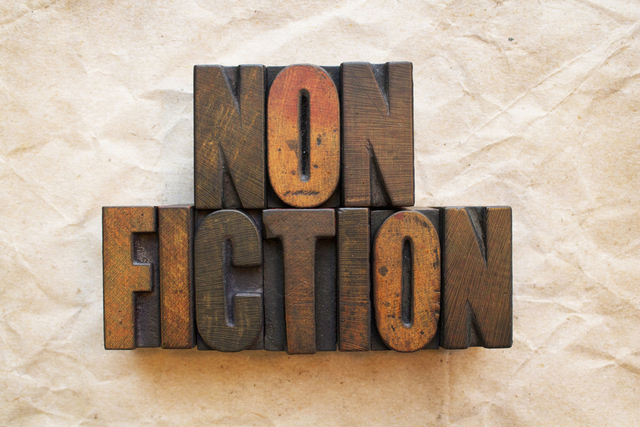
You probably have knowledge and experience that the world wants to hear about. Why not join the financially rewarding path of non-fiction book publishing?
Self-help literature, in particular, can offer a consistent stream of income for writers. Plus, a non-fiction book can lead to other income opportunities like motivational speaking, coaching, and consulting work.
Excellent non-fiction guides are equal parts knowledge, inspiration, and entertainment.
You are probably eager to get writing, but organizing and structuring your book first will help you create a readable book that will inspire others and bring you success. You need a structure to make sure readers get your message.
Here’s how to organize your knowledge to make it accessible, informative, and entertaining to your readers.
Your Book’s Promise
The 7 structural steps, writing your book, plan your way to success.
Before you start writing, decide on the focus of your book. What will your reader gain from reading your book? That’s your promise to the reader, the reason they will buy and read your book.
If your book is about parenting, is it for single or married parents? Male or female? Brainstorm ideas for what you promise your reader and who that reader is.
What results will the reader have after reading? Drill down to specifics. Is your book for single dads? Busy moms with several children?
Your promise determines the structure of your book. Once you isolate your promise to the reader, you can build the parts of your book. Each part leads your reader to the solution you promise.
Order your book parts so they lead your reader from the idea behind your information to the steps to lead them through achieving their goal – your promise.
1. Table of Contents
The table of contents is like an outline for your reader. No matter how much you strive to make your book flow from one point to another, not everyone will read the entire book, nor will they read what you’ve written in order.
Creating a table of contents gives your reader a sense of the book’s logic and makes every chapter accessible on its own.
In a paperback, your table of contents allows your reader to flick to the chapter they want to read next. In an eBook, you can make each heading clickable so that readers can navigate easily between chapters.
Having a strong table of contents which tells readers exactly what they’ll find in each chapter turns your book into a resource that they can use time and time again.
2. Introduction
Your introduction is a high-level view of the book. Introduce your topic and address the reader’s motive. Normally, the reader has a particular problem they want to fix or an opportunity they want to explore.
The introduction isn’t necessarily about you, it’s about your reader. Address their issue first and then introduce yourself and explain why you are uniquely qualified to help the reader.
Once you’ve assured the reader you can answer their question or help them gain a new skill, round off with an overview of what they will learn in the coming pages.
Depending on your topic promise and your style, the introduction can range in length from one page to 30 pages. The length doesn’t matter. Take only as long as you need to give your high-level view.
3. Glossary
A glossary of terms is optional, but will always be helpful if your book is teaching a skill or discipline like medicine, economics, or publishing. You may understand the terms and acronyms of your field, but your reader may not.
List each term with a short, single-paragraph definition or explanation. Your glossary will be of particular help to a general reader who is entering your area of expertise.

4. Outcome Benefits
Energize your reader by showing them what they will achieve. Use a success story example of what will happen if they implement your lessons.
A well-behaved dog, a successful cross-country ski trek, doubled income – paint a picture in their mind of what they can do and how they will feel after reading your book.
Your words will inspire your reader to keep reading by adding texture and clarity to their outcome. They will want to put your lessons into action to create their own success story. Success stories lead to better reviews on your book and more opportunities for you.
5. Mindset Principles
Explain the attitude and motivation your reader will need to reach success. Readers who don’t master the right mindset will probably fail at the lessons that follow.
They may not know to tackle the hardest thing first, or how to achieve the awareness and mindfulness needed to make decisions.
To absorb your practical lessons, your reader needs to understand how attitude affects outcome. Understanding mindset principles is key to working through self-help books on any subject.
6. The Body of Your Non-Fiction
Once you’ve led your reader through the logic, the dream of accomplishment, and the mental attitude necessary for success, walk them through the steps and practical tips they need to find the solution that motivated them to buy your book.
Be specific, outlining exact strategies they can take action on immediately. While you want to start chapters at a high level, sub-chapters should be full of granular advice and case studies showing how to use your advice in specific situations.
Don't include too much. Inform rather than overwhelm. Readers won't feel cheated by a shorter book so long as it teaches them what they want to know. Some of history’s most successful self-help guides are under 200 pages. Napoleon Hill’s classic Think and Grow Rich is a little over 200 pages.
On the other hand, don’t withhold vital information. Don’t save your best tips for something else. Readers want to be able to solve their problem now, not pay for a marketing pitch for a more expensive solution later.
The best self-help books tend to order the meat of their content in one of two different structures:
- Content grouped into themes
- Content structured in order of difficulty, from the fundamentals for newbies to advanced strategies for seasoned enthusiasts
Your content should always be logical and easy to navigate with clear steps that guide the readers to the information that they want. Beyond this, your structure should depend entirely on what will work best for your book.
Let’s work through some examples.
If your book is a memoir, you’ll want to make a point about what your life experiences have taught you. Your promise to your reader is to impart the conclusions you reached, and to tell them how they can benefit from your new understanding and philosophy of life.
Memoirs work best by grouping the content into themes. Select highlights from your life that illustrate your themes well. Readers don’t want to read your entire life story, only the bits that will help them.
If you’re focussing on a practical task, like learning a new skill, or are writing to address a specific set of problems, structure your chapters by the order of challenges. Start with beginner practices and build on each lesson.

7. Give Your Book Context
Readers who have read your book and liked your information will want more.
Once you’ve taught the reader all the information they wanted to learn when they picked up your book, set your lessons within a wider context. Follow up with suggestions for next steps and resources to expand their knowledge and build on their success.
For example, a book on growing a successful Instagram following can help people achieve growth, but your readers will want to know what to do next.
For example, they can leverage that following to solidify their place as an influencer on other platforms, or look into speaking gigs to grow their audience beyond the online sphere.
Give your reader ways to contact you, like joining your mailing list for more tips. This is your opportunity to guide readers into your sales funnel for courses or coaching, retreats, or adventures.
As eager as you are to share your expertise, you’ll find that planning the structure will help you write faster. This may feel like you’re slowing the whole process down but, with a solid structure, you’ll know what to include in each section of your book.
With your outline as your guide, you’ll find you write faster. You won’t have to stop and think about what comes next.
How to Follow the 7 Step Structure
Fill out notes for each of the seven sections. Where you’ll start, what your reader will learn, and any action steps for your reader.
When you get to the body of your book, organize the chapters by theme or progressive steps. Make notes about the content of each chapter. Again, where you’ll start, what your reader learns, and action steps.
Your writing needs to be as clear and easy to follow as possible in a non-fiction book. When you already know all of the steps and processes you are writing about, it can be difficult to see when you need to make something clearer or explain it in a new way.
Get someone else to read over each chapter of your book to check that they understand your process. This will help you see where your book might be confusing or require further consideration.
Writing Style
It might seem counter-intuitive, but one of the best ways to prove yourself as an expert in your field and a valuable source of information is to make your writing as simple as possible.
Jargon and long complex sentences might make you feel advanced, but they’ll make your work more challenging for your reader to understand and engage with.
Rather than aiming for the most impressive sentences possible, you should aim to for easy readability. To give you a head start, why not use ProWritingAid?
Readability scores tell you how easy it is for someone to read your work. The ProWritingAid Readability Report looks at factors like sentence length, syllable density, and word familiarity to tell you what groups of readers will be able to access your text.
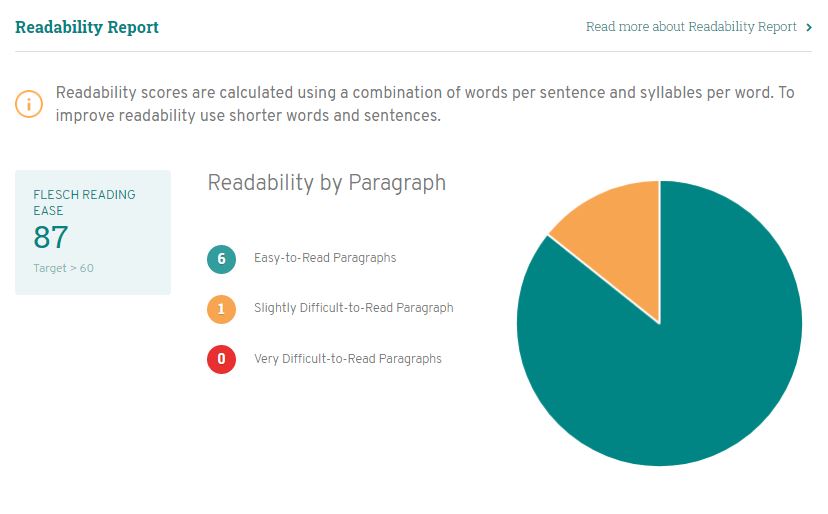
The higher the readability score, the more advanced your text is and the harder it is to comprehend. Why not run a chapter of your non-fiction book through ProWritingAid to see how you score?
If you follow this structure when you write, your notes will guide you through writing each section to lead your reader to their personal success.
Your reader’s success is your success, so plan well.
Are you prepared to write your novel? Download this free book now:

The Novel-Writing Training Plan
So you are ready to write your novel. excellent. but are you prepared the last thing you want when you sit down to write your first draft is to lose momentum., this guide helps you work out your narrative arc, plan out your key plot points, flesh out your characters, and begin to build your world..

Be confident about grammar
Check every email, essay, or story for grammar mistakes. Fix them before you press send.
Zara Altair writes traditional mysteries set in ancient Italy under Ostrogoths rule in The Argolicus Mysteries. She teaches mystery screenwriters and novelists at Write A Killer Mystery. She creates semantic web content for a select clientele.
Get started with ProWritingAid
Drop us a line or let's stay in touch via :
- Group Program Members Area

How to Structure a Nonfiction Book for an Exceptional Story
by The Book Professor | Apr 5, 2019 | How to write a book , Select Uncategorized , Writing Nonfiction | 0 comments

I don’t care if your passion is about a new business process that can save time and dollars, a memoir about overcoming pain and suffering, or if it’s about how to connect on a soul-level with your dog: if you have a passionate solution, someone else needs it. People don’t buy books, they buy solutions. Someone is looking for what’s trapped inside you.
When it comes to crafting your exceptional story, it can be difficult to know where and how to begin. I’m here to help you design your story so you can start writing and get your message out into the world. As a book coach , my life is spent working with individuals who have a story to tell, and helping them share that story in a way that moves people to action.
What is your story?
All of us have our own story , and people are truly interested in hearing it. Every day, each of us are asked questions such as:
- What do you do?
- What are you passionate about?
- Where did you go to school?
- Do you have kids?
Even if people aren’t directly asking about your story, these types of questions are indirect ways to try to learn more about you and the story you have to tell.
Physiologically, humans are wired to enjoy and relate to stories. Stories have been a part of the human fabric since the beginning of time. People like to listen to stories, relate to them, and remember them. Find your story and give people what they crave!
It’s important to understand the difference between telling your story and presenting your resume. You cannot tell your exceptional story by reciting a list of your accomplishments or delivering an elevator pitch. You need to dig deeper. Your story will communicate who you are, so you need to figure out exactly who that is and how to showcase that person.
Start with the foundation of your story
Before you start writing your story, you need to answer two questions:
- What is the purpose of your story?
- Who is the audience?
Stories can help you cross racial, social-economical, political, and religious, boundaries; they are that powerful. I believe there are two key things all people need: hope and help . Your story has the power to offer hope and help to others. Your story can change lives and have an impact on society, but you need to decide just what kind of impact you want to make. What do you want your story to communicate? What change do you want to invoke in the reader? How will your story help people?
Knowing your audience is essential. Your target audience will determine what you tell them and why. Cater your story to grab the interest of your audience, so that you can deliver a helpful and memorable story. Take a look at my blog post, How to Define an Audience for Your Book , for a more in-depth explanation of how to tackle this important task.
Outline the three parts of your story to lay the plan for your nonfiction book
Obviously, all stories have a beginning, middle, and end, but the three parts I suggest you consider are these:
- What it used to be like
- What happened
- What it’s like now
Start with what life was like before the change happened. Were you happy? Overworked? Unfulfilled? Paint a picture of your “before” and set your audience up for the change.
The “what happened” section is the turning point in your story. It’s your pivotal moment, the bridge that connects the before and after. Something happened that caused a change in your life, and that’s what you’ll share with your audience. Some changes are internal, such as an “aha!” moment that directed you to take action or make a change, but some people need more of a push. External changes are things that force us into change, such as the death of a family member, birth of a child, a divorce, loss of a job, or some other life-altering occurrence. What happened to you? How did it force you to change and why?
Create closure in your story
Next, tell your audience what it’s like now. Where are you in your life? How are things different?
If you’re struggling with how to wrap up the impact of your life or a specific chapter in your story, consider these six areas of your life and how they have been impacted by the events you shared in your memoir or business book:
- Relationships
- Professional,
How have these areas of your life been affected?
If you take these three aspects–What it Used to be Like, What Happened and What It’s Like Now–put them together, and seal them with a solid purpose statement that clearly communicates the purpose of your story, you will have a solid design in place.
You have a story to tell, and people are ready to hear it, but whether or not they will relate to it and remember it depends on how well you tell it. How you tell your story is just as important as the story itself. I can help you craft your story and work with you when you have trouble writing. Don’t let fear of writing keep you from sharing your story with the world!
If you need help to write your book, consider working with me as you write your first book. Details below!
- Personal book writing coach
- Group book coaching program
- Online book writing class (self paced)
How can we help?
- Author Tools
- Autobiography
- Book Design
- Book Marketing
- Book Writing Software
- How to publish a book
- How to write a book
- Life Coach Book
- Nonfiction Writing
- Online Writing
- Public Speaker Book
- Published Authors & Books
- Select Uncategorized
- Self Help Book
- Self Publishing
- Social Media for Authors
- Storytelling
- Write a business book
- Writing Inspiration
- Writing Nonfiction
- Writing Tips
Looking to publish? Meet your dream editor, designer and marketer on Reedsy.
Find the perfect editor for your next book
1 million authors trust the professionals on Reedsy. Come meet them.
Guides • Perfecting your Craft
Posted on Apr 22, 2021
Outlining a Nonfiction Book: 3 Steps to Success
Readership of nonfiction books has been growing strong in the last couple of years — so making sure your book is well-crafted enough to stand out is more important than ever. And while the plotter-vs-pantser debate is still lively for fiction titles, the case is less divisive for nonfiction. Knowing how to outline a nonfiction book is an essential part of creating a compelling and helpful title that readers will love.
With these three key steps, you’ll organize your knowledge and plan your research so that you’re ready to write an amazing book (or ebook )!
❗ Note that this post deals mostly with writing expository (informational) nonfiction rather than narrative nonfiction. If your book idea follows a clearer narrative arc, check out our post on how to outline a memoir .
Step 1: Determine the key purpose of your book
First and foremost, you should always keep in mind throughout this process that you’re writing a book for others to read. And readers will always expect a nonfiction book to help them with something, whether that’s gathering more knowledge or achieving something. As such, you need to determine a key question which your book answers, something that can address the target audience’s pain points or pique their interest.

FREE OUTLINING APP
The Reedsy Book Editor
Use the Boards feature to plan, organize, or research anything.
Set the one big question that your book will answer
Having a key question will help you keep your book focused and coherent since you’ll always be trying to answer it. It’s also a great way to get readers interested, as the question ought to be something that they want the answer to.
For instance, let’s say “Hana” is an expert on the market of coffee beans — so the trading of beans from growers to coffee shops — and she wants to write a book about that.

Hana knows that coffee-lovers have become more conscious about the source of their drinks and that most books in the market right now either cover recipes or history. She then decides that her book will fill the gap in the market and answer the question: Where does my coffee come from? This can be interpreted in several ways, as we’ll see in the next step.

GET ACCOUNTABILITY
Meet writing coaches on Reedsy
Industry insiders can help you hone your craft, finish your draft, and get published.
Identify your target audience
You can’t write a book without thinking about who your target audience is, because they’re ultimately the people who want to use your nonfiction book. Think about who they are, what they care about, and what they read. Your book should address their interests or concerns, otherwise, they wouldn’t be compelled to read it.
Free course: Finding your target readers
Identify your target readers, find out where they 'live', and get them to buy your book. Get started now.
You can also check out the competition — books in the same genre or share the same Amazon keywords and categories — to see what kind of content and styles are well-loved. Again, understanding your potential readers will help you refine the key message of your book so that it can help them. This is an important exercise in understanding where your book will fit into the nonfiction market, an element you will need to be confident about if you ever approach a literary agent or traditional publisher with hopes of securing a book deal .
💡 You need to write a book proposal if you want to submit to a publisher, and a nonfiction query letter if you want to query a literary agent.
Store all your knowledge in one place
Start by looking at what you know. You have a topic in mind already, so begin by just dropping everything you know about it into one place (preferably somewhere that you can easily access and search later, like the Reedsy Book Editor or a Word document). You can organize everything in list form, as headings and subheadings, or as a mind map — whatever works best for you.
Simply by putting down everything you know, you might realize that there are some things you want to focus on more than others. Highlight those to think about regarding your book’s key topic while keeping the rest handy — you’ll return to all of this as you outline your nonfiction book.
💡 Looking for the perfect piece of software to help you plan and write your book? Check out our list of the best book writing software , or take this quiz to get a tailored recommendation.
Which writing app is right for you?
Find out here! Takes 30 seconds
Step 2: Structure your book to best address the main problem
Now’s the time to organize all your thoughts and create a rough skeleton of your book. You’ll need to arrange your knowledge into a logical string of thoughts that will best help readers find the answer to your question.
It might help to borrow some principles from how a school syllabus is planned. Each seminar has a learning objective that contributes to the desired outcome of the whole series. You start with the fundamentals, assuming that most participants don’t know much about the topic (which is why they’re taking the course). The same thinking can help you structure each chapter in your nonfiction book!

But what exactly is the best way to organize these “seminars”? Every book is a little different, but we’ve got several common structures here for you to consult. We’ll also examine how Hana’s hypothetical book idea can be applied to some of these, so you can see how your approach depends on your purpose and target audience.
The step-by-step structure
As the name indicates, this kind of structure best fits instructional nonfiction books, like your “how-to” guides. Each chapter or part should align with a step in a process to do or achieve something. For instance, in Reedsy co-founder Ricardo Fayet’s How to Market a Book , following the introduction, we follow a loose step-by-step structure:
- You start with knowing your market and creating a book that has the potential to do well in it;
- Then you optimize your book’s external appearance, like its cover and blurb;
- Once that’s done, you go on to advertisements and promotional programs for your book;
- And on the journey goes.
There’s a logical sequence to this kind of book because some things you just can’t do effectively before others (i.e. you need to have a good book with a nice cover first before you can run advertisements about it).
As such a structure is clear and actionable, it’s often used in personal finance and business books, like those about finding a way to improve your financial situation or start a business.
Free course: How to write a business book
How can writing a book revolutionize your business? Only one way to find out.
The essay structure
If you’re not describing a process, then perhaps this structure is more suitable. Remember how you were taught to write essays in school? You start with an introduction that presents the question, and then each of your following paragraphs examines a part of the answer to that question. In the end, you summarize and evaluate your points to give a final answer. As you make your way to the end of the essay, you follow a clear and easy-to-follow narrative arc . This same structure can help you outline your nonfiction book.
Let’s look at how Hana, our coffee expert, might use the essay structure:

Hana’s book can open with a nice, casual anecdote about getting coffee, which is then countered with her own less common point of view from behind the scenes. Her following chapters look at:
- Where coffee is grown, and by whom;
- How beans are exported;
- A review of the world economy and its exploits (including the coffee trade);
- How big chains like Starbucks get their beans;
- How small coffee shops get their beans;
- What this means for the reader, and what they should do in response.
The list structure
The list structure is pretty straightforward — essentially, your nonfiction book is a list of things. You’ll encounter this more in children’s books , like Vashti Harrison’s Little Leaders , which talks about bold Black women in history and their achievements. That doesn’t mean, however, that you can’t create lists for an older audience. Aside from cookbooks , reference, coffee-table, and photography books, list books are a popular format for introductions to new subjects — take Michiko Kakutani’s Ex Libris: 100+ Books to Read and Reread , for example.
You do want to prepare more information when writing for an adult audience — a variety of evidence, some visual content, or even some personal evaluation on some of the items of the list will make your book more interesting and insightful.
If Hana chooses this route, she can create a master list of coffee bean producers or coffee bean varieties from across the world. This is a great chance to incorporate photographs into her book, present it more like a catalog for artisanal coffee shop owners and their loyal customers. Can you think of a more fabulous coffee-table book?
The chronological structure
Like a memoir, your book can also be organized in chronological order. Naturally, this works best when you have a very compelling anecdote to follow, and if you think it’s best for your readers to learn through the journey. The story could be yours or that of someone you knew, interviewed, or researched.
[skip to 5:00 in the video below to learn more about nonfiction structure]

Let's see how Hana's coffee book might benefit from the chronological structure:
Hana can consider sharing her personal career, to show how she’d come to appreciate coffee and its producers so much that she had to write a book . She can outline the nonfiction book so it follows her own transition from someone who drinks just about any kind of coffee to one who can notice the nuances in the taste of different types of beans. How has coffee changed her life? She now sees a fuller picture of the supply chain, which raises questions about international trade and conscious consumption that she hadn’t thought about before…
Readers get to follow that journey with Hana. This book isn’t just about coffee. Consumers will feel connected to or curious about her journey as a person, especially if she’s a big name in the food and beverage industry.
There are plenty of nonfiction books out there with other structures, it’s best to read ones on the same topic as yours to see how they approach it. Figuring out which structure suits you will guide you to creating your provisional table of contents (in other words, your chapter-by-chapter outline). It’s much easier to do this with a nonfiction book than it is for a fiction book, and it can give you the guidance you need when you write later.
Step 3: Sketch out your chapters
Now you’ve nailed the key question and the main structure, it’s time to flesh things out a little. This is a good chance to review your strategy so far, see if any chapter is looking too short, needs more research, or needs to be relocated. By taking some of those ideas from the vault of knowledge you created in the first step and plucking them into the outline, you reassess the whole structure.
Include a mix of facts and anecdotes
Having a couple of bullet points about the chapter’s main message, some evidence, and perhaps an interesting personal story or two usually bodes well. The latter acts as a hook to your chapter, keeping the reader interested, and is especially useful in less narrative-based nonfiction books.
Say Hana decides to write an essay-structured nonfiction book — she now needs to outline her chapters. The chapter on how coffee beans are exported would naturally talk about how countries like Brazil export raw beans for cheap prices, but it can also open with one of Hana’s work stories, like when she went to Brazil on a business trip.
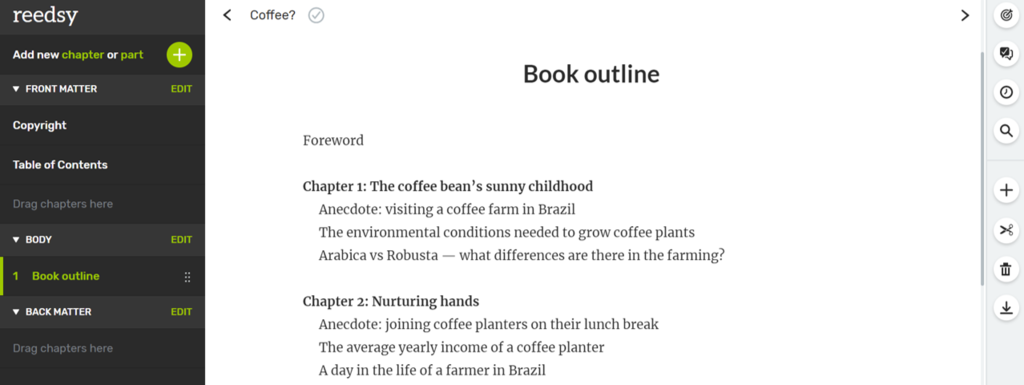
Revise as needed
While this outline will ideally provide the guidance for your writing, it doesn’t have to be the exact structure of your final book. After all, the structure you end up with is just one way to think about this topic that you want to write about, and we know now how many approaches there can be. So throughout the writing or editing process , reassess your structure and adjust it if need be.
With the chapters briefly outlined, you’ll have finished the plan for your book. What comes next is incredibly important.
- If your goal is to self-publish, then head straight to our post on writing your nonfiction book.
- Should you wish to go the traditional route and sell your book to a publisher, read our post on publishing nonfiction before you start drafting — you'll see why soon enough!
Join a community of over 1 million authors
Reedsy is more than just a blog. Become a member today to discover how we can help you publish a beautiful book.
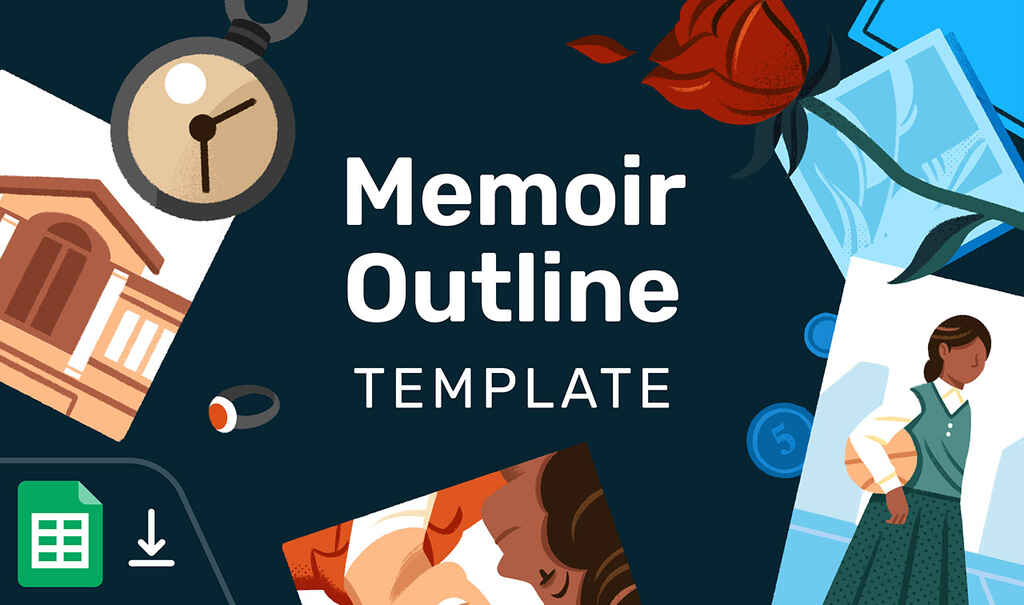
Structure your memoir for maximum impact
Use our free template to plan an unputdownable memoir.

1 million authors trust the professionals on Reedsy. Come meet them.
Enter your email or get started with a social account:
How to Write a Book Review: Awesome Guide

A book review allows students to illustrate the author's intentions of writing the piece, as well as create a criticism of the book — as a whole. In other words, form an opinion of the author's presented ideas. Check out this guide from EssayPro — book review writing service to learn how to write a book review successfully.
What Is a Book Review?
You may prosper, “what is a book review?”. Book reviews are commonly assigned students to allow them to show a clear understanding of the novel. And to check if the students have actually read the book. The essay format is highly important for your consideration, take a look at the book review format below.
Book reviews are assigned to allow students to present their own opinion regarding the author’s ideas included in the book or passage. They are a form of literary criticism that analyzes the author’s ideas, writing techniques, and quality. A book analysis is entirely opinion-based, in relevance to the book. They are good practice for those who wish to become editors, due to the fact, editing requires a lot of criticism.
Book Review Template
The book review format includes an introduction, body, and conclusion.
- Introduction
- Describe the book cover and title.
- Include any subtitles at this stage.
- Include the Author’s Name.
- Write a brief description of the novel.
- Briefly introduce the main points of the body in your book review.
- Avoid mentioning any opinions at this time.
- Use about 3 quotations from the author’s novel.
- Summarize the quotations in your own words.
- Mention your own point-of-view of the quotation.
- Remember to keep every point included in its own paragraph.
- In brief, summarize the quotations.
- In brief, summarize the explanations.
- Finish with a concluding sentence.
- This can include your final opinion of the book.
- Star-Rating (Optional).
Get Your BOOK REVIEW WRITTEN!
Simply send us your paper requirements, choose a writer and we’ll get it done.
How to Write a Book Review: Step-By-Step
Writing a book review is something that can be done with every novel. Book reviews can apply to all novels, no matter the genre. Some genres may be harder than others. On the other hand, the book review format remains the same. Take a look at these step-by-step instructions from our professional writers to learn how to write a book review in-depth.

Step 1: Planning
Create an essay outline which includes all of the main points you wish to summarise in your book analysis. Include information about the characters, details of the plot, and some other important parts of your chosen novel. Reserve a body paragraph for each point you wish to talk about.
Consider these points before writing:
- What is the plot of the book? Understanding the plot enables you to write an effective review.
- Is the plot gripping? Does the plot make you want to continue reading the novel? Did you enjoy the plot? Does it manage to grab a reader’s attention?
- Are the writing techniques used by the author effective? Does the writer imply factors in-between the lines? What are they?
- Are the characters believable? Are the characters logical? Does the book make the characters are real while reading?
- Would you recommend the book to anyone? The most important thing: would you tell others to read this book? Is it good enough? Is it bad?
- What could be better? Keep in mind the quotes that could have been presented better. Criticize the writer.
Step 2: Introduction
Presumably, you have chosen your book. To begin, mention the book title and author’s name. Talk about the cover of the book. Write a thesis statement regarding the fictitious story or non-fictional novel. Which briefly describes the quoted material in the book review.
Step 3: Body
Choose a specific chapter or scenario to summarise. Include about 3 quotes in the body. Create summaries of each quote in your own words. It is also encouraged to include your own point-of-view and the way you interpret the quote. It is highly important to have one quote per paragraph.
Step 4: Conclusion
Write a summary of the summarised quotations and explanations, included in the body paragraphs. After doing so, finish book analysis with a concluding sentence to show the bigger picture of the book. Think to yourself, “Is it worth reading?”, and answer the question in black and white. However, write in-between the lines. Avoid stating “I like/dislike this book.”
Step 5: Rate the Book (Optional)
After writing a book review, you may want to include a rating. Including a star-rating provides further insight into the quality of the book, to your readers. Book reviews with star-ratings can be more effective, compared to those which don’t. Though, this is entirely optional.
Count on the support of our cheap essay writing service . We process all your requests fast.
Dive into literary analysis with EssayPro . Our experts can help you craft insightful book reviews that delve deep into the themes, characters, and narratives of your chosen books. Enhance your understanding and appreciation of literature with us.

Writing Tips
Here is the list of tips for the book review:

- A long introduction can certainly lower one’s grade: keep the beginning short. Readers don’t like to read the long introduction for any essay style.
- It is advisable to write book reviews about fiction: it is not a must. Though, reviewing fiction can be far more effective than writing about a piece of nonfiction
- Avoid Comparing: avoid comparing your chosen novel with other books you have previously read. Doing so can be confusing for the reader.
- Opinion Matters: including your own point-of-view is something that is often encouraged when writing book reviews.
- Refer to Templates: a book review template can help a student get a clearer understanding of the required writing style.
- Don’t be Afraid to Criticize: usually, your own opinion isn’t required for academic papers below Ph.D. level. On the other hand, for book reviews, there’s an exception.
- Use Positivity: include a fair amount of positive comments and criticism.
- Review The Chosen Novel: avoid making things up. Review only what is presented in the chosen book.
- Enjoyed the book? If you loved reading the book, state it. Doing so makes your book analysis more personalized.
Writing a book review is something worth thinking about. Professors commonly assign this form of an assignment to students to enable them to express a grasp of a novel. Following the book review format is highly useful for beginners, as well as reading step-by-step instructions. Writing tips is also useful for people who are new to this essay type. If you need a book review or essay, ask our book report writing services ' write paper for me ' and we'll give you a hand asap!
We also recommend that everyone read the article about essay topics . It will help broaden your horizons in writing a book review as well as other papers.
Book Review Examples
Referring to a book review example is highly useful to those who wish to get a clearer understanding of how to review a book. Take a look at our examples written by our professional writers. Click on the button to open the book review examples and feel free to use them as a reference.
Book review
Kenneth Grahame’s ‘The Wind in the Willows’
Kenneth Grahame’s ‘The Wind in the Willows’ is a novel aimed at youngsters. The plot, itself, is not American humor, but that of Great Britain. In terms of sarcasm, and British-related jokes. The novel illustrates a fair mix of the relationships between the human-like animals, and wildlife. The narrative acts as an important milestone in post-Victorian children’s literature.
Book Review
Dr. John’s ‘Pollution’
Dr. John’s ‘Pollution’ consists of 3 major parts. The first part is all about the polluted ocean. The second being about the pollution of the sky. The third part is an in-depth study of how humans can resolve these issues. The book is a piece of non-fiction that focuses on modern-day pollution ordeals faced by both animals and humans on Planet Earth. It also focuses on climate change, being the result of the global pollution ordeal.
We can do your coursework writing for you if you still find it difficult to write it yourself. Send to our custom term paper writing service your requirements, choose a writer and enjoy your time.
Need To Write a Book Review But DON’T HAVE THE TIME
We’re here to do it for you. Our professionals are ready to help 24/7
How To Write A Book Review?
What to include in a book review, what is a book review, related articles.
%20(2).webp)
- Skip to main content
- Skip to footer
Additional menu
The Creative Penn
Writing, self-publishing, book marketing, making a living with your writing
Structure And Organize Your Non-Fiction Book
“Non-fiction requires enormous discipline. You construct the terms of your story, and then you stick to them.” Barbara Kingsolver

As thriller author, Jeffrey Deaver once said, “The reader is god.” You need to please the reader if you want more sales, more reviews and more lives changed.
I’ve often found that the structure of my non-fiction books only falls into place once I have written quite a few chapters. I’ll have lots of placeholders that disappear, are absorbed into other chapters or expanded into new sections. So, don’t worry if you’re struggling with structure.
You don’t need to nail it up front, just be aware of it, and keep iterating as you write.
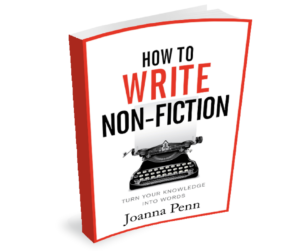
Think in Parts or Sections First
These broad categories will help you fill in the blanks later. For How To Write Non-Fiction , it was obvious that I needed a section on Before you Write, then one on the actual writing, then publishing and then marketing. That is a clear linear progression for this book and your journey as an author.
For The Healthy Writer , we struggled on the order of the chapters until late in the writing process when it became clear that the transformation was from Unhealthy to Healthy Writer. We structured the book into those two main parts, and then everything fell into place.
Outline your draft Table of Contents
Now you have your specific topic and a lot of research notes, it's time to start outlining your table of contents. You've gone wide with a lot of ideas, but now you need to bring the content back to what will be relevant for this particular book.
You'll likely cut a lot of your material out, and some of your ideas might even end up in another book. When I wrote Business for Authors: How to be an Author Entrepreneur , I had a whole load of ideas on the psychology of writing. But that section ended up growing so big that I carved those chapters out and they became the seed of The Successful Author Mindset .
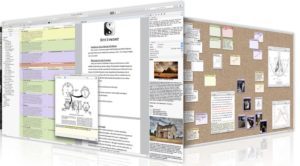
Of course, you can use MS Word, Google Docs, another word processing program, or spreadsheets. Whatever works for you.
You could also use mind mapping, a visual way of organizing information. Start by writing the main topic in the middle of the page and then brainstorm outwards, creating hierarchical branching trees that go deeper into each sub-topic. There are lots of different software options for mind mapping, but you can also just use pen and paper to get the ideas flowing.
If you prefer to talk through your ideas, try dictation . Or you could ask someone to interview you on your chosen topic, and use the transcript as the basis for your Table of Contents.

Use sub-headings
If you want to take your organization a step further, you can use sub-headings within each chapter to split the material into easily digestible chunks. Many non-fiction readers skim through books, looking for the most pertinent and useful sections, and sub-headings help the reader find what they’re looking for.
Other sections to consider
At this stage, you can use placeholder headings to collect other material and ideas. This can be firmed up later as you work through the book, but it's a good idea to make sure you collect it all along the way.
You might want to include extras like case studies, checklists, exercises, downloadable audio or workbook pages, images, illustrations and other extras. These can be self-contained in the book or you can include links back to your website for multi-media.
Resources, bibliography and references. Keep a list as you go so it’s not a nightmare to collect at the end. Trust me, I know all about that!
Foreword and blurb quotes
You certainly don't need a foreword. But if you do want one and have someone in mind, then make sure you ask them well in advance. The same goes for blurb quotes. Just ask in advance and keep a note of people to contact later.
Acknowledgments
This is where the author credits the people who helped bring the book into being, so keep a list of people you work with along the way so you can pull it together later.
Your credentials and experience, or whatever makes you interesting.
Email list sign-up
You want to be able to capture people's email addresses so you can contact them later for marketing reasons, or when you have a new book. [For more on that, check out my author website tutorial here .]
Consider what you will offer at the end of the book to entice them to sign up, or whether you have something extra as part of the book e.g. downloadable audio.
By now, you should have a list of chapters that you need to fill in.
This is an excerpt from How to Write Non-Fiction: Turn Your Knowledge into Words by Joanna Penn. Available in ebook, print, audiobook and workbook formats.
Need more help?

- My Books for Authors , including How to Write Non-Fiction
- My Courses for Authors , including How to Write Non-Fiction, and How to Write a Novel
- The Creative Penn Podcast , interviews, inspiration and information on writing, publishing, book marketing and creative entrepreneurship every Monday
- My videos at YouTube.com/thecreativepenn


Connect with me on social media
Sign up for your free author blueprint.
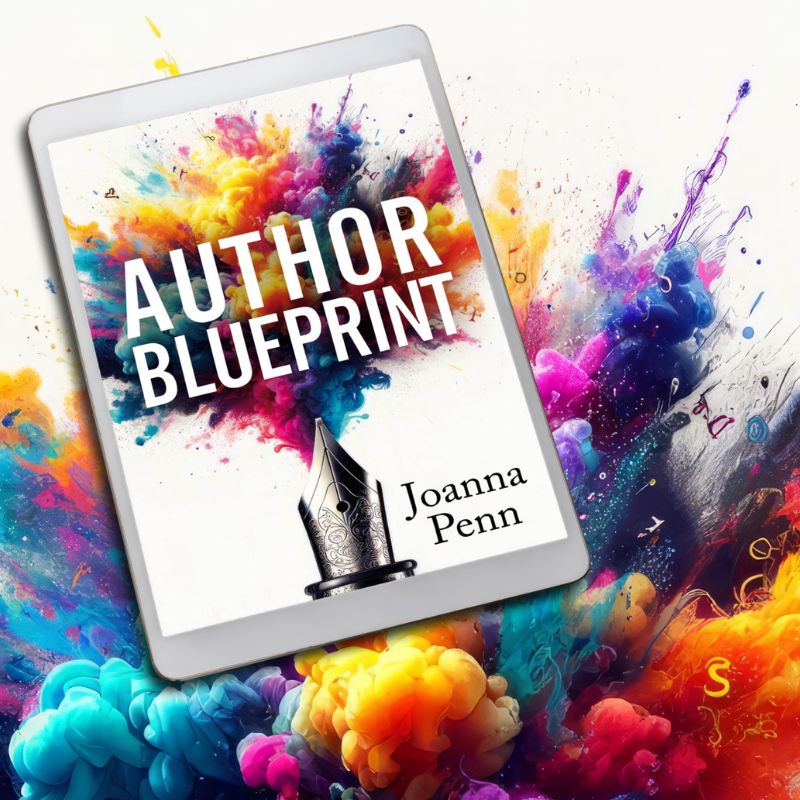
Thanks for visiting The Creative Penn!

How to plan and outline a non-fiction book
WRITING | 0 comments

Non-fiction covers a lot of bases including memoir, self-help, true crime, how-to and history. Whatever type of non-fiction book you want to write, this guide will offer a step by step process that will get you closer to your writing goal
contains affiliate links
Both of my non-fiction books are very different. One is a mental health memoir and the other is a how-to guide for freelancers called Out of Office , but both began with a sense of curiosity. I think writing should come from creativity, first and foremost, so I don’t advise that you to plan your book writing process based on trends or trying to fill a gap in the market.
Instead, challenge yourself to dream up an idea for a book that you would simply love to write. Because the reality is that it can take anywhere between six and twelve months to write a non-fiction book and it requires a lot of focus, so above all you should make sure that you enjoy the process as much as possible.
There are a lot of books out in the world, and as little as 1% of them will end up becoming bestsellers so your book might not become an overnight success, but you should still aim to feel proud of what you’ve written.
Open your mind to new ideas for your book by consuming new topics in the form of books, podcasts, magazines, newspaper articles, movies and documentaries. Keep a notepad handy at all times to make a note of any ideas that come to mind, and enjoy this exploratory phase of writing. I also find it helpful to journal on a daily basis as this allows me to organise my thoughts and free write about anything that’s on my mind. You’ll be surprised at how many brainwaves you have when you’re journaling about nothing in particular.

Once you’ve spent a few weeks (or months) mulling over your idea, set aside a day to get everything out on the page. First of all, get a large piece of paper and write down all your thoughts about the book you’re considering writing. I find doing this with pen and paper is much more effective than writing out words into a document. Try creating a mind map based on a few of the larger topics and gradually noting down any threads attached to each one.
For example when I was brainstorming my book Out of Office one of the main topics was mental health. The threads attached to that were words like social media, taking time off, isolation, money worries, etc. Once you’ve done this for several topics you’ll start to see just how much information you have to work with, how they link together and how it will form the structure of your book.
If you feel ready to start structuring your non-fiction book then you can move onto the next step. However, if you feel like there are a few gaps in your knowledge or some interesting threads you’d like to follow a little further then now is a good time to do some research.
Dig deeper into the content you consumed at the ‘be curious’ stage. Look at the bibliographies in the books you read, read newspaper articles and biographies on the people who interest you the most. For non-fiction books, I love using the Blinkist app to get a general overview of the key ideas of the books I’m interested in before I read the full book. Audiobooks are another great way to deepen your understanding of a particular subject area, before you settle on a book idea.

Pick a structure
The structure for your non-fiction book will depend on the type of book you want to write. In my mental health memoir, I open the story at a dramatic low point which took place in my late twenties, a sort of prologue which sets the tension early on. After that, I use a fairly standard chronological structure that follows my childhood through to the present day. In Out of Office, I structured the book to follow the typical journey of someone who wants to go freelance. I start by explaining what freelancing is, lay out the pros and cons and then offer practical advice on how to get started, grow and develop over time.
Your book might offer a step by step process to solve a specific problem. In which case, you should aim to write the book in a way that makes this as easy as possible for the reader to follow. For example, you’ll probably need to explain some of the concepts early on in the book to allow the reader to understand and implement the advice you give later in the book.
Read more about different book structures
I like to organise my ideas visually, and this is how I’ve planned all of the non-fiction books I’ve written. Take a look at the mindmap you’ve created and cross out anything that is no longer relevant.
Now, get a stack of post it notes and copy a single word or idea onto each note and stick them on a blank wall. You’ll end up with lots and lots of sticky notes, but now you can rearrange them into a loose structure. Group similar topics together, then rearrange them into an order that makes sense for the reader. For example, when planning Out of Office, it made sense to talk through basics like how to raise an invoice before more advanced chapters such as how to raise your prices.
You might find that some topics are actually themes and crop up several times throughout the book. That’s OK, just write a few more notes and stick them in wherever you need them.
For example, in my mental health memoir I knew I wanted to talk about my love for writing as a child, then contrast that with my lack of creativity as an adult. Similarly, in Out of Office, isolation is something I write about in multiple chapters of the book as it makes sense to talk about the widespread issue in the beginning and then offer advice to manage it later in the book.

Draft an outline
For me, the whole point of this process is to create a book outline that will then act as a guideline to write the book. If you’re creating a book proposal to send out to agents or publishers then you’ll need an outline as part of that, but even if you’re self-publishing you’re going to need some sort of plan in place before you sit down to write. Using the post it notes you rearranged earlier, you should now see the basis of your outline. Remember to include a short introduction, then divide the book into sections, then headings, then subheadings. It’s OK if you’re not 100% sure of the chapters and their exact order. You can only plan so much and a lot of the answers you’re looking for will become clear through the process of writing the book.
Now you should have a loose plan for your non-fiction book. If you’d like more support on actually writing your book, you might be interested in my Find Your Voice course which teaches you techniques on how to hone your writing style and write from personal experience.
Further reading:
How to Write Non-Fiction by Joanna Penn https://uk.bookshop.org/a/4750/9781912105779
You Can’t Make This Stuff Up by Lee Gutkind https://uk.bookshop.org/a/4750/9780738215549
Share this:
- Click to share on Twitter (Opens in new window)
- Click to share on Facebook (Opens in new window)
Submit a Comment Cancel reply
Your email address will not be published. Required fields are marked *
Notify me of follow-up comments by email.
Notify me of new posts by email.
This site uses Akismet to reduce spam. Learn how your comment data is processed .

As Seen On:

- Customer service work ruined my mental health
- The truth about giving up alcohol
- Turning 30 and I still don't want kids - what's wrong with me?
- 3 Ways to Fit Writing Around Your Full-Time Job
- Why I had to lose my career to save my mental health
- How to pitch an article idea to a magazine: Email examples included
Become a Bestseller
Follow our 5-step publishing path.
Fundantals of Fiction & Story
Bring your story to life with a proven plan.
Market Your Book
Learn how to sell more copies.
Edit Your Book
Get professional editing support.
Author Advantage Accelerator Nonfiction
Grow your business, authority, and income.
Author Advantage Accelerator Fiction
Become a full-time fiction author.
Author Accelerator Elite
Take the fast-track to publishing success.
Take the Quiz
Let us pair you with the right fit.
Free Copy of Published.
Book title generator, nonfiction outline template, writing software quiz, book royalties calculator.
Learn how to write your book
Learn how to edit your book
Learn how to self-publish your book
Learn how to sell more books
Learn how to grow your business
Learn about self-help books
Learn about nonfiction writing
Learn about fiction writing
How to Get An ISBN Number
A Beginner’s Guide to Self-Publishing
How Much Do Self-Published Authors Make on Amazon?
Book Template: 9 Free Layouts
How to Write a Book in 12 Steps
The 15 Best Book Writing Software Tools
How To Write A Nonfiction Book: 21 Steps for Beginners
POSTED ON Oct 14, 2020

Written by Scott Allan
The steps on how to write a nonfiction book are easy to follow, but can be difficult to execute if you don't have a clear plan.
Many first time authors experience information overload when it comes to writing a nonfiction book. Where do I start? How do I build authority? What chapters do I need to include? Do I know enough about this topic?
If you're mind is racing with questions about how to get started with your book, then you’ve landed in the right place!
Writing a book can be a grueling, lengthy process. But with a strategic system in place, you could become a nonfiction book author within three to four months.
However, you need an extremely high level of motivation and dedication, as well as a clear, proven system to follow.
In this article, we’ll cover all there is to know about the nonfiction book writing process.
Need A Nonfiction Book Outline?
How to write a nonfiction book
Writing a nonfiction book is one of the most challenging paths you will ever take. But it can also be one of the most rewarding accomplishments of your life.
Before we get started with the steps to write a nonfiction book, let's review some foundational questions that many aspiring authors have.
What is a nonfiction book?
A nonfiction book is based on facts, such as real events, people, and places. It is a broad category, and includes topics such as biography, memoir, business, health, religion, self-help, science, cooking, and more.
A nonfiction book differs from a fiction book in the sense that it is real, not imaginary.
The purpose of nonfiction books is commonly to educate or inform the reader, whereas the purpose of fiction books is typically to entertain.
Perennial nonfiction books are titles such as How to Win Friends and Influence People from Dale Carnegie, A Brief History of Time by Stephen Hawking, and Anne Frank's The Diary of a Young Girl .
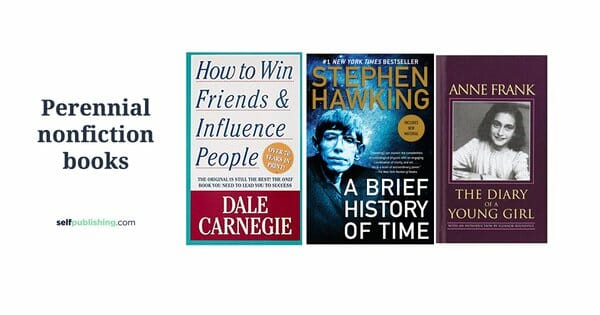
What is the author’s purpose in a work of nonfiction?
In a nonfiction book, the author’s main purpose or reason for writing on the topic is to inform or educate readers about a certain topic.
While there are some nonfiction books that also entertain readers, the most common author's purpose in a work of nonfiction is to raise awareness about a certain topic, event, or concept.
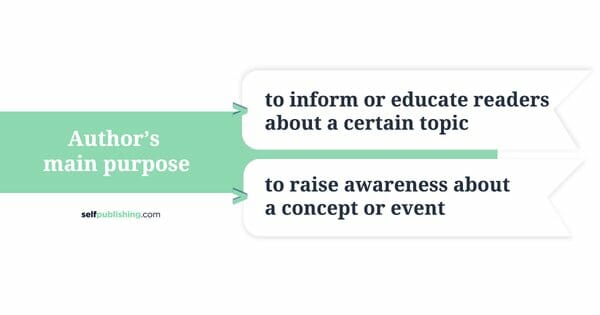
How many words are in a nonfiction book?
Because nonfiction is such a broad category, it really depends on the type of nonfiction you are writing, but generally a nonfiction book should be about 40,000 words.
To determine how many words in a novel , narrow down your topic and do some research to see what the average word count is.
Use this Word & Page Count Calculator to calculate how many words you should aim for, based on your genre and audience.
How long does it take to write a nonfiction book?
It can take anywhere from three months to several years to write a nonfiction book, depending on the author's speed, research process, book length, and other variables.
On average, it can take a self-published author typically six months to one year to write their nonfiction book. However, that means the author is setting time aside daily to work on their book, staying focused, and motivated.
Other nonfiction authors, especially those with heavy research an in–depth analysis can take much longer. How long it takes to write a nonfiction book really just depends on several factors.
Benefits of writing a nonfiction book
Making a decision to write a book could change your life. Just think about all the ways you could leverage your expertise!
If you’re interested in how to write a book , it’s important to understand all the things writing the book can do for you, so that you can stay motivated throughout the process.
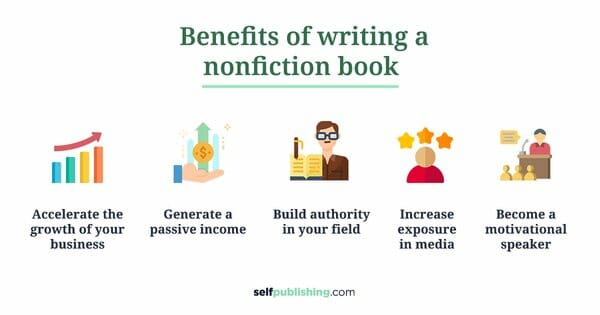
Some rewarding results that can come after you write a nonfiction book are:
- Exponentially accelerate the growth of your business
- Generate a stream of passive income for years to come
- Build authority in your field of expertise
- Increase exposure in the media
- Become a motivational speaker
- …and so much more (this is just the beginning)!
Imagine for a moment …walking into your local bookstore and seeing your book placed at the front of the store in the new releases section. Or browsing on Amazon KDP , the world’s largest online bookstore, and seeing your nonfiction book listed as a bestseller alongside well-known authors.
It can happen in as little as three months if you are fully committed and ready to start today.

How to Write a Nonfiction Book in 21 Steps
You're clear on the type of nonfiction book you want to write, and you're ready to get started.
Before you start writing, it's time to lay the groundwork and get clear on the entire process. This will help you manage your book writing expectations, and prepare for the nonfiction book writing journey that lies ahead.
With those foundational questions out of the way, let’s move on to 21-step checklist so you can start learning exactly how to write a nonfiction book.
#1— Develop the mindset to learn how to write a nonfiction book
The first step in how to become an author is to develop a rock solid author mindset. Without a writer’s mindset, you are going to struggle to get anywhere with your book. Writing has more to do with your attitude towards the craft than the skill required to get you there.
If writing words down and tying sentences together to craft a story is the skill, your mindset is the foundation that keeps this motivation moving forward.
Identifying yourself as a writer from the start (even if you haven't published yet) will form the mindset needed to continue working on your book .
To succeed, you must toughen up so that nothing gets in your way of writing.
This is also known as imposter syndrome : A psychological pattern where a person doubts their accomplishments and has an ongoing internalized fear of being exposed as a fraud.
Here’s how to prevent imposter syndrome as an aspiring author:
- Define what it means to be an author or writer. Is this someone who wakes up at 5am and writes 1000 words a day?
- Tell yourself you’re a writer. Just do it. It feels strange at first but you will begin to believe your own self-talk.
- Talk about your book idea . That’s right – start telling people you are writing a book. Many writers working on a book will keep it a secret until published. Even then, they might not about it.
- Take action to build author confidence. Imposter syndrome paralyzes you. Focus on increasing your author confidence and getting rid of doubt. This can be done by committing to writing every day. Just 500 words is enough. Build that writing habits early and you’ll be walking and talking like a true author.
#2 – Create a Book Writing Plan
Excuses will kill your chances of becoming a published author. There are no good reasons for not writing a book, only good excuses you convince yourself are real.
You are trying to protect yourself from embarrassment, only to create a new kind of shame: the shame of not finishing the book you have been talking about for years.
Some of the most common excuses that hold writers back are: There is no time to write in my life right now. I can't get past my distractions. I can never be as good as my favorite famous author. My book has to perfect.
Excuses are easy to dish out. But identifying them for what they are (excuses), is the first step towards taking action and changing your limiting mindset.
Excuses, while they may seem valid, are walls of fear. Banish your excuses right now and commit to writing your book.
Here's how to overcome the excuses that prevent you from writing:
- Make the time to write. Set up a thirty-minute time block every day. Commit to writing during this time.
- Turn off your distractions. Get rid of the WiFi for an hour. Close the door. It is just you and the story.
- Be aware of comparisons to other writers. They worked hard to get where they are, and you will get there, too.
- Give yourself permission to write badly. It won’t be perfect, but a book that is half-finished can’t be published.
#3 – Identify your WHY
Start with this question: “Why am I doing this?”
Know your why . This is critical to moving ahead with your book idea. We usually have an intrinsic and extrinsic reason for wanting to learn how to write a nonfiction book.
Intrinsic Why: What is your #1 reason for wanting to write this book? Is it a bucket list goal you must achieve? Is it to help people overcome a root issue in their lives? Do you want to create a movement and generate social impact?
Extrinsic Why: Do you want to create a business from your book? Have passive income coming in for many years later? Become a full-time author and work from home? Grow your network? Build an online presence?
Getting super clear on why you want to write a bestselling book is the momentum to propel you forward and deliver your story. Enlisting the help of a book writing coach (like we offer here at SelfPublishing!) can also help you stay close to your why. This person will be your sounding board, motivation, and voice of reason during the writing process – providing much-needed support from someone who's published multiple books before.
#4 – Research nonfiction book topics
Whether you have a clear idea of what you want to write about or if you are still exploring possible topic ideas, it's important to do a bit of market research.
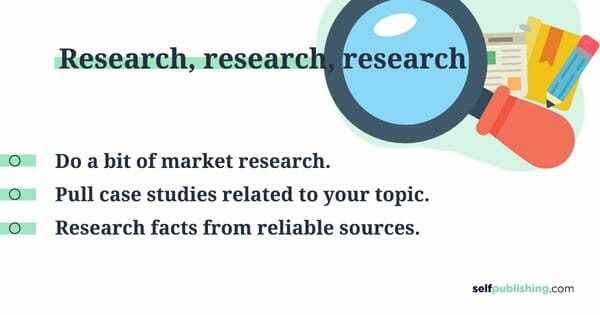
Researching the current news and case studies related to your potential topic are powerful ways to add credibility to your nonfiction book, and will help you develop your own ideas.
This adds greater depth to your nonfiction book, builds better trust with readers, and delivers content that exceeds customer expectations.
If you need help narrowing down your book idea, try experimenting with some writing prompts based on the genre you're interested in!
Here's how to write a nonfiction book that's well-researched:
- Use case studies. Pull case studies and make reference to the research. If there are not any case studies related to your topic, explore the idea of creating your own case study.
- Read books related to your topic. Mention good books or articles to support your material.
- Research facts from reliable sources. Post proven facts and figures from reliable sources such as scholarly journals, academic papers, white papers, newspapers, and more.
#5 – Select a nonfiction book topic
What are you writing about? It starts with having a deep interest and passion for the area you are focused on.
Common topics to write a nonfiction book on are:
- Business and Money
- Health, dieting and exercise
- Religion and Spirituality
- Home repair
- Innovation and entrepreneurship
You probably already know this so it should be easy. Make a note of the area you are writing your book on. And then…
#6 — Drill down into your book idea
Everyone starts at the same place. It begins with an idea for the book.
What is the core idea for your book? If your nonfiction book topic is on health and dieting, your idea might be a book on “How to lose 7 pounds in your first month.”
Your book is going to be centered around this core idea.
You could have several ideas for the overall book but, to avoid writing a large, general book that nobody will read, make it more specific.
#7 — Schedule writing time
What gets scheduled, gets done. That’s right, you should schedule in your writing time just like any other appointment on your calendar.
Your writing routine will have a large role to play when it comes to writing and finishing your book.
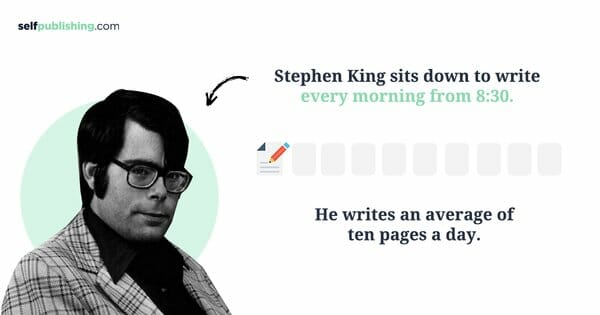
Scheduling time for writing, and sticking to it, will help you knock out your writing goals with ease.
Stephen King sits down to write every morning from eight-thirty. It was his way of programming his brain to get ready for the day’s work. He writes an average of ten pages a day.
W.H. Auden would rise at six a.m. and would work hard from seven to eleven-thirty, when his mind was sharpest.
When do you feel the most productive? If you can, make time for writing at the same time every day to set the tone for your writing productivity.

Commit to a time of day and a length of time during which to write. Set a goal for yourself and try to hit the target every day by sticking with your routine.
#8 — Establish a writing space
You need a place to write, and you must establish that space where you can write everyday, distraction-free for several hours a day.
Your writing environment plays a critical role in your life as an author. If you write in a place that’s full of noise, uncomfortable to be in, or affects your emotional state to the point you don’t want to do anything, you might consider your environment needs some work.
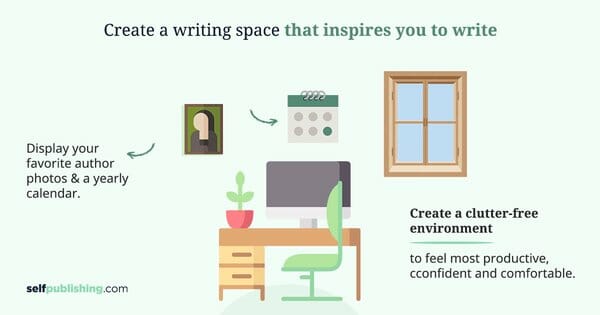
Here is how to create a writing space that inspires you to write:
Display your favorite author photos
Find at least twenty photos of authors you want to emulate. Print these out if you can and place them around your room. An alternative idea is to use the photos as screensavers or a desktop screen. You can change the photo every day if you like. There is nothing like writing and having your favorite author looking back at you as if to say, “Come on, you’ve got this!”
Hang up a yearly calendar
Your nonfiction book will get written faster if you have goals for each day and week. The best way to manage this is by scheduling your time on a calendar. Schedule every hour that you commit to your author business.
As Bob Goff said, “The battle for happiness begins on the pages of our calendars.”
Buy a big wall calendar. Have enough space on each day that you can write down your goals for that day. When you have a goal for that day or week, write it down or use a sticky note.
Create a clutter-free environment
If there is any one factor that will slow you down or kill your motivation, it is a room full of clutter.
If your room looks like a tornado swept through, it can have a serious impact on your emotional state. What you see around you also occupies space in your mind. Unfinished business is unconsciously recorded in your mind and this leads to clutter (both physical and mental).
Although you can’t always be in complete control of your physical space, you can get rid of any clutter you have control over. Go for a simple workplace that makes you feel relaxed.
Choose a writing surface and chair
Consider a standing desk, which is becoming popular for many reasons. Sitting down for long periods of time becomes uncomfortable and unhealthy. You can balance your online time between sitting and standing.
For sitting, you want a chair that is comfortable, but not too comfortable. Invest in a chair that requires you to sit up straight. If there is a comfortable back attached, as with most chairs, you have a tendency to get sleepy. This can trigger other habits as well, such as craving television.
Seek out the place where you can be at your most productive and feel confident and comfortable.
#9 — Choose a nonfiction book writing software
This is one of the most important writing tools you will choose. Your writing software needs to be efficient, easy to use and stress-free. Anything that requires a lot of formatting or a steep learning curve could end up costing you time and patience.
There are literally dozens of choices for book writing software , so it's really just a matter of finding what works best for you.

Here are 3 writing software for new authors to consider:
- Microsoft Word. Before any other writing tools came along, Microsoft Word was the only option available. Today, even though there are many other word processors out there, millions of people continue to use it for their writing needs. And it’s easy to see why. It’s trusted, reliable, and gets the job done well .
- Google Docs . It's a stripped-down version of Word that you can only use online. Some perks are that it comes with the built-in ability to share content, files, and documents with your team. You can easily communicate via comments for collaboration. If you write your book in Google Docs, you can share the link with anyone and they can edit , or make any changes right in the document itself. And all changes are trackable!
- Scrivener . A lot of writers absolutely love this program, with its advanced features and distraction-free writing experience. Scrivener was designed for writers; it’s super easy to lay out scenes, move content around, and outline your story, article, or manuscript. If you’re serious about learning how to write a nonfiction book, then putting in the time to learn this writing tool will definitely be worth it.
There are many forms of writing software that all have advantages to using them, but once you find what works for you, stick with it.
#10 — Create your mind map
A mind map is a brain dump of all your ideas. Using your theme and core idea as a basic starting point, your mind map will help you to visually organize everything into a structure for the book.
I highly recommend using pen and paper for this. You will enjoy the creative flow of this process with a physical version of the map rather than mind mapping software. But, if you prefer using an app to create your mindmap , you can try MindMeister .
Here is how to create your mind map:
- Start with your central idea. Write this idea in the center of the map.
- Add branches connecting key ideas that flow out from the core idea.
- Add keywords that tie these key ideas together.
- Using color coded markers or sticky notes, and identify the chapters within your mindmap.
- Take your chapter headings and…
#11 — How to write a nonfiction book outline
Now that your book topic is decided on, and you have mind mapped your ideas, it’s time to start determining how to outline a nonfiction book.
There are several ways to create a book outline , and it really boils down to author preference and style.
Here's how to write a nonfiction book outline:
- Use this Book Outline Generator for a helpful template to follow for your own outline.
- Map out your book's topics with a mindmap or bubble map, then organize similar concepts together into chapters.
- Answer the 5 Ws: Who, What, When, Where, Why.
- Use book writing software outline tools, like Scrivener's corkboard method.

What is a nonfiction book outline?
A book outline is a roadmap or blueprint for your story. It tells you where you need to go and when in chronological order.
Take the common themes of your chapters and, if applicable, divide your chapters into sections. This is your smooth transition from tangled mind map to organized outline.
Note that not every book needs sections; you might have chapters only. But if your chapters can be grouped into 3-6 different themes within the book, create a section for those common-themed chapters and group them together into a section.
The outline needs to be easy to follow and generally no more than a couple pages long.
The goal here is to take your mind map and consolidate your ideas into a structure that makes logical sense . This will be an incredible roadmap to follow when you are writing the book.
No outline = writing chaos.
There are two types of book outlines I will introduce here:
Option 1: Simple Nonfiction Book Outline
A simple book outline is just like it sounds; keep it basic and brief. Start with the title, then add in your major sections in the order that makes sense for your topic.
Don’t get too hung up on the perfect title at this stage of the process ; you just want to come up with a good-for-now placeholder.
Use our Nonfiction Book Title Generator for ideas.
Option 2: Chapter-by-Chapter Nonfiction Book Outline
Your chapter-by-chapter book outline is a pumped-up version of the simple book outline.
To get started, first create a complete chapter list. With each chapter listed as a heading, you’ll later add material or move chapters around as the draft takes shape.
Create a working title for each chapter. List them in a logical order. After that, you’ll fill in the key points of each chapter.
Create a mind map for each chapter to outline a nonfiction book
Now that you have a list of your chapters, take each one and, similar to what you did with your main mind map for the book, apply this same technique to each chapter.
You want to mind map 3-7 ideas to cover in each chapter. These points will become the subtopics of each chapter that functions to make up chapter structure in your nonfiction book.
It is important to not get hung up on the small details of the chapter content at this stage. Simply make a list of your potential chapters. The outline will most likely change as you write the book. You can tweak the details as you go.
#12 — Determine your point of view
The language can be less formal if you are learning how to write a self-help book or another similar nonfiction book. This is because you are teaching a topic based on your own perspective and not necessarily on something based in scientific research.
Discovering your voice and writing style is as easy as being yourself, but it’s also a tough challenge.
Books that have a more conversational tone to them are just as credible as books with more profound language. You just have to keep your intended audience in mind when deciding what kind of tone you want to have in your book.
The easiest way to do this is to simply write as you would talk, as if you were explaining your topic to someone in front of you – maybe a friend.
Your reader will love this because it will feel like you are sitting with them, having a cup of coffee, hanging out and chatting about your favorite topic.

#13 — Write your first chapter
As soon as you have your nonfiction book outline ready, you want to build momentum right away. The best way to start this is to dive right into your first chapter.
You can start anywhere you like. You don’t have to start writing your nonfiction book in chronological order.
Take a chapter and, if you haven’t yet done so, spend a few minutes to brainstorm the main speaking points. These points are to be your chapter subheadings.
You already have the best software for writing, you’re all set in your writing environment, now you can start writing.
But wait…feeling stuck already?
That’s okay. You might want to start off with some free flow writing. Take a blank page and just start writing down your thoughts. Don’t think about what you are writing or if it makes any sense. This technique is designed to open up your mind to the flow of writing, or stream of consciousness
Write for 10-15 minutes until you are warmed up.
Next, dive into your chapter content.
#14 — Write a nonfiction book first draft
The major step in how to write a nonfiction book is – well, to actually write the first draft!
In this step, you are going to write the first draft of your book. All of it. Notice we did not say you were going to write and edit . No, you are only writing.
Do not edit while you write, and if you can fight temptation, do not read what you’ve written until the first draft is complete.
This seems like a long stretch, to write a 30-40,000-word book without reading it over, but…it’s important to tap into your creative mind and stay there during the writing phase.
It is difficult to access both your writing brain and editing brain at the same time. By sticking with the process of “write first, edit later,” you will finish your first draft faster and feel confident moving into the self-editing phase.
To learn how to write a nonfiction book, use this format:
- Mind map your chapter —10 minutes
- Outline/chapter subheadings—10 minutes
- Research [keep it light]—20 Minutes
- Write content—90 minutes
After you're done with your rough draft (first draft) you'll move on to the second draft/rewrite of your book when you will improve the organization, add more details, and create a polished draft before sending the manuscript to the editor.
#15 — Destroy writer’s block
At some point along the writer’s journey, you are going to get stuck. It is inevitable.
It is what we call the “messy middle” and, regardless you are writing fiction or nonfiction, it happens to everyone. You were feeling super-pumped to get this book written but halfway through, it begins to feel like an insurmountable mountain that you’ll never conquer.
Writer’s block is what happens when you hit a wall and struggle to move forward.
Here is what you can do when you find yourself being pulled down that dark hole.
Talk back to the voices trying to overpower your mind. Your internal critic is empowered when you believe what you are listening to is true.
Bring in the writer who has brought you this far – the one who took the initiative to learn how to write a nonfiction book. Be the writer that embraces fear and laughs at perfectionistic tendencies. Be that person that writes something even if it doesn’t sound good. Let yourself make mistakes and give yourself permission to fail.
Use positive affirmations are therapy for removing internal criticism.
Defeat the self-doubt by not owning it. Your fears exist in your mind. The book you are writing is great, and it will be finished.
Now, go finish it…
#16 — Reach out to nonfiction book editors
Before you start your second rewrite, consider reaching out to an editor and lining someone up to professionally edit your book. Then, when you have completed your self-editing process, you can send your book to the editor as quickly as possible.
Just as producing a manuscript involves a varied skill set—writing, formatting, cover design, etc.— so does editing it.
Do not skimp on quality when it come to editing – set aside money in your budget when determining the costs to publish your book .
Getting a quality edit should be the #1 expenditure for your book. It doesn’t matter if you think you’re a fantastic writer—we all make small mistakes that are difficult to catch, even after reading through the book several times.
You can find good editors on sites such as Upwork or through recommendations from other authors.
#17— Self-edit your first draft
You completed the major step in how to write a nonfiction book: You’re rough draft is finished. Now it is time to go through your content page per page, line per line, and clean it up.
This is where is gets messy. This is the self-editing stage and is the most critical part of the book writing process.
You can print out the entire manuscript and read through it in a weekend. Arm yourself with a red pen and several highlighters. You’ll be marking up sentences and writing on the page.
Start with a verbal read through.
Yes, actually read your draft out loud to yourself; you'll be surprised how reading it verbally allows you to spot certain mistakes or areas for improvement.
A verbal read through will show you:
- Any awkward phrasing you’ve used
- What doesn’t make sense
- Typos (the more mistakes you find, the less an editor will accidentally overlook)
Questions to ask as you self-edit your nonfiction book:
- What part of the book is unclear or vague?
- Can the “outsider” understand the point to this section without being told?
- Is my language clear and concrete?
- Can I add more detail or take detail out?
- Can the reader feel my passion for writing and for the topic I am exploring?
- What is the best part of this section and how can I make the other parts as good as the best section?
- Do I have good transitions between chapters?
For printed out material take lots of notes and correct each page as you go. Or break it down by paragraphs and make sure the content flows and transitions well.
Take 2-3 weeks for the self editing stage. The goal isn’t to make it perfect, but to have a presentable manuscript for the editor.
If you let perfection slip in, you could be self-editing and rewriting six months from now. You want to get your best book published, but not have it take three years to get there.
And, when the self edit is finished…
#18 — Create a nonfiction title
The title and subtitle is critical to getting noticed in any physical or online bookstore, such as Amazon.
Related: Nonfiction Book Title Generator
Set aside a few hours to work on crafting your perfect title and subtitle. Keep in mind that needs to engage your potential readers to buy the book.

The title is by far one of the critical elements of the books’ success .
Here are the main points to consider when creating a nonfiction book title:
- Habit Stacking
- Example#1: Break the Cycle of Self-Defeat, Destroy Negative Emotions and Reclaim Your Personal Power
- Example#2: How to Save More Money, Slash Your Spending, and Master Your Spending
Write down as many title ideas as you can. Then, mix and match, moving keywords around until you come up with a title that “sticks.”
Next, test your title by reaching out for feedback – this can be from anyone in your author network. Don’t have an author community to reach out to?
Consider attending some of the best writers conferences to start networking with other writers and authors!
You can also test your title on sites like PickFu .
#19 — Send your nonfiction book to the editor
In a previous step, you hired your editor. Now you are going to send your book to the editor. This process should take about 2-3 weeks. Most editors will do two revisions.
When you receive your first revision, take a few days to go through the edits with track changes turned on. Carefully consider the suggestions your editor is making.
If you don’t agree with some of the suggested edits, delete them! Your editors don’t know your nonfiction book as well as you do.
So, while expert feedback is essential to creating a polished, professional-quality book, have some faith in yourself and your writing.
Now that the editing is done, you are preparing for the final stage…
#20 — Hire a proofreader
Even with the best of editors, there are often minor errors—typos, punctuation—that get missed. This is why you should consider hiring a proofreader—not your editor—to read through the book and catch any last errors.
You don’t want these mistakes to be picked up by readers and then posted as negative reviews.
You can find proofreaders to hire in your local area, or online, such as Scribendi Proofreaders or ProofreadingServices.com
Some great proofreading apps to use are Grammarly and Hemingway Editor App .
When you are satisfied that the book is 100% error free and stands up to the best standard of quality, it is time to…
#21 — Hire a formatter
Congratulations…you’re almost there! Hiring your book formatter is one of the final stages before publishing.
Nothing can ruin a good book like bad formatting. A well-formatted book enhances your reader's experience and keeps those pages being turned.
Be sure that you have clear chapter headings and that, wherever possible, the chapter is broken up into subheadings.
You can hire good formatters at places like Archangelink , Ebook Launch , and Formatted Books .
Here are the key pages to include in your nonfiction book:
Front Matter Content
- Copyright page
- Free gift page with a link to the opt-in page (optional)
- Table of contents
- Foreword (optional)
Back Matter Content
- Lead magnet [reminder]
- Work with me (optional)
- Acknowledgements (optional)
- Upcoming books [optional]
Now, work together with your formatter and communicate clearly the vision for your book. Be certain your formatter has clear instructions and be closely involved in this process until it is finished.
You know how to write a nonfiction book!
Now that you know the entire process to write your book, it's time to move on to the next phase: publishing and launching your book!
For publishing, you have two options: traditional publishing and self publishing. If you’re completely new to the book writing scene, you may want to check out this article which goes over self publishing .
If you’re deciding between self publishing vs traditional publishing , do some research to choose the right option for you.
Once you get to the marketing phase, be sure to use the Book Profit Calculator to set realistic goals and get your book into the hands of as many readers as possible!
Take some time to celebrate your accomplishing of learning how to write a nonfiction book, then get to work on publishing and launching that book!
What questions do you still have on how to write a nonfiction book?

Related posts
Non-Fiction
Need Some Memorable Memoir Titles? Use These Tips
Business, Marketing, Writing
Amazon Book Marketing: How to Do Amazon Ads
Writing, Fiction
How to Write a Novel: 15 Steps from Brainstorm to Bestseller

Write Compelling Non-Fiction With Structured Methods: A Guide for Aspiring Authors

Affiliate Disclaimer
As an affiliate, we may earn a commission from qualifying purchases. We get commissions for purchases made through links on this website from Amazon and other third parties.
Writing non-fiction can be a challenging task, especially when trying to keep readers engaged and interested in the topic. However, with the right methods and structure, it is possible to write compelling non-fiction that captures the attention of readers and keeps them engaged throughout the entire piece.
One of the key elements to writing compelling non-fiction is having a clear and well-structured outline. This allows the writer to organize their thoughts and ideas in a logical manner, making it easier for readers to follow along and understand the main points being presented. Additionally, having a clear outline can help the writer stay focused and on track, avoiding unnecessary tangents or distractions.
Another important aspect of writing compelling non-fiction is understanding the needs and interests of the target audience. This involves conducting research and understanding what topics and information are most relevant and interesting to the readers. By tailoring the content to the audience, the writer can ensure that the non-fiction piece is engaging and informative, and ultimately provides value to the reader.
Understanding Non-Fiction

Defining Non-Fiction
Non-fiction refers to any form of writing that is based on facts, real events, and real people. It is a genre of literature that deals with the representation of reality. Non-fiction can take many forms, including memoirs, biographies, essays, and journalism. The main objective of non-fiction is to inform, educate, and explain.
One of the key features of non-fiction is its emphasis on truth. Non-fiction writers are expected to present factual information in an accurate and unbiased manner. This means that they must conduct extensive research to ensure that their work is based on reliable sources. Non-fiction writers must also be careful not to misrepresent their subjects or distort the facts.
Importance of Structure
Structure is a critical component of non-fiction writing. A well-structured piece of non-fiction is easier to read and understand. It also helps the writer to present their ideas in a logical and coherent manner. A structured approach to non-fiction writing involves breaking down the work into smaller sections, each with its own focus and purpose.
One effective method of structuring non-fiction writing is the use of outlines. An outline is a plan that outlines the main points of a piece of writing. It helps the writer to organize their thoughts and ideas and to ensure that they stay on track. Another important aspect of structure in non-fiction writing is the use of headings and subheadings. These help to break up the text and make it easier to read.
In conclusion, non-fiction is a genre of literature that deals with reality. It is based on facts and real events, and its main objective is to inform, educate, and explain. Structure is a critical component of non-fiction writing, and it helps to make the work easier to read and understand. By using effective methods of structuring, non-fiction writers can create compelling works that engage and inform their readers.
Research and Resources

Gathering Information
Before starting to write non-fiction, it is important to conduct thorough research to gather all the necessary information. This can be done through a variety of methods, including reading books , articles, and academic papers, conducting interviews, and attending events related to the topic.
One effective way to gather information is by using online resources such as academic databases, government websites, and news outlets. These sources can provide valuable data, statistics, and expert opinions on the topic at hand.
Another method is to conduct primary research, which involves collecting data through surveys, experiments, or observations. This can provide unique insights and perspectives that are not available through secondary sources.
Evaluating Sources
When conducting research, it is important to evaluate the credibility and reliability of the sources used. This can be done by considering factors such as the author’s credentials, the publication date, and the publisher’s reputation.
One effective way to ensure the reliability of sources is by using academic databases and peer-reviewed journals. These sources have been reviewed by experts in the field and are generally considered to be trustworthy.
It is also important to consider the bias of sources and to seek out multiple perspectives on a topic. This can help to avoid a one-sided or incomplete view of the subject.
Overall, conducting thorough and reliable research is essential for writing compelling non-fiction. By using a variety of sources and carefully evaluating their credibility, writers can provide readers with accurate and informative content.
Crafting the Narrative

Crafting a compelling non-fiction narrative requires a structured approach. The narrative should be built around a central theme and should have a clear narrative arc that keeps the reader engaged. In this section, we will discuss how to develop the theme and create a narrative arc.
Developing the Theme
The theme is the central idea that the narrative revolves around. It should be something that is relevant to the reader and should be explored in depth throughout the narrative. The theme should be introduced early on in the narrative and should be woven into the story in a way that is subtle but effective.
To develop the theme, the author should ask themselves what the story is really about. They should think about the message they want to convey and how they want the reader to feel after reading the narrative. Once the theme has been identified, the author should use it to guide the narrative and ensure that all aspects of the story support the theme.
Creating a Narrative Arc
The narrative arc is the structure that holds the story together. It should have a clear beginning, middle, and end, and should take the reader on a journey. The narrative arc should be designed to keep the reader engaged and interested in the story.
To create a narrative arc, the author should start by introducing the main characters and setting the scene. They should then introduce the conflict or problem that the characters will face. This conflict should be resolved by the end of the narrative, providing a satisfying conclusion for the reader.
The narrative arc should be designed to build tension and keep the reader engaged. The author should use a variety of techniques such as foreshadowing, cliffhangers, and plot twists to keep the reader guessing and interested in the story.
In conclusion, crafting a compelling non-fiction narrative requires a structured approach. The narrative should be built around a central theme and should have a clear narrative arc that keeps the reader engaged. By developing the theme and creating a narrative arc, the author can create a story that is both informative and engaging.
Writing Techniques

Writing non-fiction can be a challenging task, especially when it comes to keeping the readers engaged throughout the entire piece. Structured writing techniques can help non-fiction writers to create compelling content that keeps readers interested from beginning to end. Some of the techniques that can be used include incorporating fiction techniques, interviews, and personal stories.
Incorporating Fiction Techniques
Fiction techniques can be used in non-fiction writing to make the content more engaging and interesting. For instance, using descriptive language and vivid imagery can help to create a mental picture in the reader’s mind. This can help to make the content more memorable and impactful.
Another technique that can be used is the use of dialogue. Dialogue can help to break up the text and make the content more conversational. This can help to create a more engaging reading experience for the reader.
Interviews and Personal Stories
Interviews and personal stories can also be used to make non-fiction writing more compelling. Including personal stories and experiences can help to create a connection with the reader. This can help to make the content more relatable and interesting.
Interviews can also be used to provide expert opinions and insights into a particular topic. This can help to add credibility to the content and make it more informative.
Overall, incorporating these techniques can help non-fiction writers to create compelling content that keeps readers engaged from beginning to end.
Editing and Refining

The Role of Editing
Editing is a crucial step in the non-fiction writing process. It’s the process of reviewing and refining your work to ensure that it’s clear, concise, and engaging. It’s essential to edit your work to ensure that it’s free from errors, inconsistencies, and inaccuracies. Editing helps to enhance the clarity and readability of your work, making it easier for readers to understand and follow your ideas.
There are several types of editing, including developmental editing, copy editing, and proofreading. Developmental editing involves reviewing the content and structure of your work, while copy editing focuses on correcting errors in grammar, punctuation, and spelling. Proofreading is the final stage of editing, which involves checking for any remaining errors before publishing.
Voice and Style Adjustments
Editing also involves adjusting your voice and writing style to ensure that it’s appropriate for your target audience. Your voice refers to the tone and personality of your writing, while your writing style refers to the way you present your ideas. Adjusting your voice and writing style can help to improve the readability and engagement of your work.
When editing, consider the following:
- Is your voice appropriate for your target audience?
- Is your writing style clear and concise?
- Are your ideas presented in a logical and organized manner?
Making adjustments to your voice and writing style can help to improve the overall quality of your work and make it more appealing to readers.
In conclusion, editing and refining your non-fiction work is essential to ensure that it’s clear, concise, and engaging. Through editing, you can improve the readability and engagement of your work, making it easier for readers to understand and follow your ideas. Adjusting your voice and writing style can also help to improve the overall quality of your work and make it more appealing to your target audience.
Latest posts

Achieving Your Word Count Goals with Daily Sprints: A Guide
Many writers struggle with meeting their word count goals, whether it’s for a school assignment, a blog post, or a novel. It can be frustrating to stare at a blank page or screen and feel like you’re not making progress. However, there is a technique that can help you achieve your word count goals and…

Beat Burnout: Setting Reasonable Writing Expectations
Writing can be a fulfilling and rewarding experience, but it can also be exhausting and draining. Writing burnout is a real phenomenon that can affect anyone, from professional writers to students. When writers push themselves too hard, they can experience stress, lack of motivation, and even physical symptoms like headaches and fatigue. To avoid burnout,…

Dealing with Criticism and Rejection as an Author: Tips and Strategies
As an author, receiving criticism and rejection is an inevitable part of the writing process. It can be difficult to navigate the emotions that come with having your work scrutinized, but it’s important to remember that criticism and rejection are not personal attacks. Instead, they are opportunities for growth and improvement. One way to deal…

How To Structure A Nonfiction Book [The Best Way]
When you write a nonfiction book the main objective is to solve the readers problem.
So having a nice structure that can convey your message to the reader is must.
That’s why you should know how to structure a nonfiction book.
This is important so as to convey your message.
And in this post I will help you on “ How to Structure a nonfiction Book ”.
When I first wrote my first nonfiction eBook ( Be Miserable or Motivate Yourself ) my first step was to structure it properly.
“Structuring a nonfiction book means how you are presenting your information and ideology in order to achieve the result you want.”
Table of Contents
How To Structure A Nonfiction Book?
There are numerous ways to structure a nonfiction book and you are not just bound to use only one format.
But here is some of the format used by many great writers which you can use in your nonfiction book.
1. Table Of Contents
One of the best way to structure a nonfiction book is by creating a table of content and outlining everything even before you start writing your first chapter.
Your table of content will help you in planning the road map of your nonfiction book so you don’t have to struggle in thinking about the next chapter.
And if you find yourself deviating from the topic that you have outlined, just take a step backward and then decide whether you have decided the right topic for the book, or if one book is not enough to write down all the ideas that you think of then you should consider writing a series instead of one book.
2. Chronological Narrative
If you want to write about some historical event or some biography, then you should present the information in linear pattern, showing and relating the events in order they happened.
Chronology is great way to structure a nonfiction book.
For example if you write about “How to Publish your first eBook”, which I did, then you should include step by step procedure starting from selection of topic to marketing the book in successive chapter wise starting from selection of topic and ideas to ending with selling that book.
But in case of some topics like historical events and biography chronological narrative may seemed boring for some readers as well as some writers.
This is because when you create a character and write about him/her starting from birth to present time it can be overwhelming for some writers as well as to some readers also.
For readers it will seems like a lifetime to read it and they may find it boring.
For memoirs, a traditional story structure would be beneficial.
3. Story Structure
If you are structuring nonfiction memoirs, the classic approach of storytelling is a perfect choice.
The beginning structure of your nonfiction book should start with the problem that needs to be solved.
After that you need to explain each and every step that a reader should follow, which will ultimately solve the problem and the reader should gain some insights on how to tackle such scenario.
That should serve as the climax of the nonfiction book.
And this explains what the reader and writer learned from the book.
Story structure not only works for memoirs but can be used to structure any book.
By framing about your techniques with similar storyline, problems to be solves, steps taken, steps to avoid, how you have solved it, and what you have learned.
This will create an impact and you will create a compelling nonfiction book that your readers will love reading.
Also this type of structure in nonfiction makes user read a nonfiction book just like a novel as they can somehow relate to the event and it feels like a story and not just a mere self-help book.
If you just want to teach something then how-to approach is great.
Suppose if you want to teach how to Cook, then stating how to in every part is convenient.
These can be a number of short How-to in a single book.
Like including different how-to recipes in a single cook book is great. This will answer readers question on how to cook and the reader will get result after each chapter.
Similarly if you are solving single-single problem under one book then this structure is a better choice.
If you want to know how to write a how-to article then read this post .
5. List/Survey
When you are sharing a broad topic which covers many examples of one kind of thing, then you should consider structuring your nonfiction book through lists and surveys.
Usually a list contains some of the top points under a single topic which can either be explained later in the upcoming chapters.
A list can be examples that you want to share with your readers or can be some of the real life case studies that will benefit them in understanding the book.
Similarly you can add surveys under a single topic to make your reader understand each topic in detail.
6. Step-By-Step Approach
Another way to structure your nonfiction book is to use step-by-step approach.
You want to teach how to do something, so your book would educate your reader using step-by-step chapters outlining the information to be gained.
The reader can easily find their way through the book and can even use your book for future reference.
7. Topic-By-Topic
If you are writing about many individual sections that don’t make sense in the next chapter or there is no link in the upcoming chapters, then structuring your nonfiction book topic-by-topic comes handy.
By this you can write about individuals without worrying about linking it in the next chapters.
And even the readers will not be confused, if you have a lengthy book.
Some Other Examples On How To Structure A Nonfiction Book
You can also try some of these structure:
- Ficformation (sometimes called informational fiction)
- Explanation/Exposition
- With Riddles
- With Question and Answers
- With Pictures and Art
- Character Worksheet
Reader Experience
Whatever structure you choose to format your nonfiction book but take your reader’s experience as your first priority.
Do not confuse your reader, or in most cases, Misguide.
A reader should get good reading experience.
A nonfiction book should solve the purpose for which readers have bought it.
“Don’t Sell the Book, Sell the Purpose.”
Your nonfiction book can do its magic only if it servers the purpose for which it had been written, else no matter how much you try to push it, it will not work at all.
You may like to read: Beginner’s Guide to Publish Ebook on Amazon [Kindle]
My Final Take On “How To Structure A Nonfiction Book?”
Writing a nonfiction book is challenging, unlike fiction books which mostly requires only imagination, the nonfiction book can be difficult as the writer have to include proper information on the chosen topic.
Every examples, every word, has to be included with proper explanation.
So by developing the structure of nonfiction book before you write, you can make sure to organize your voice and words carefully and can write in a more focused way without hampering readers’ experience.
If you have any question on “How to structure a nonfiction Book” , do ask them in the comment section. I will answer them as soon as possible.
And if this post helped you in any sense feel free to share with people who want this information.
Leave a Comment Cancel reply
This site uses Akismet to reduce spam. Learn how your comment data is processed .
10 books to add to your reading list in April
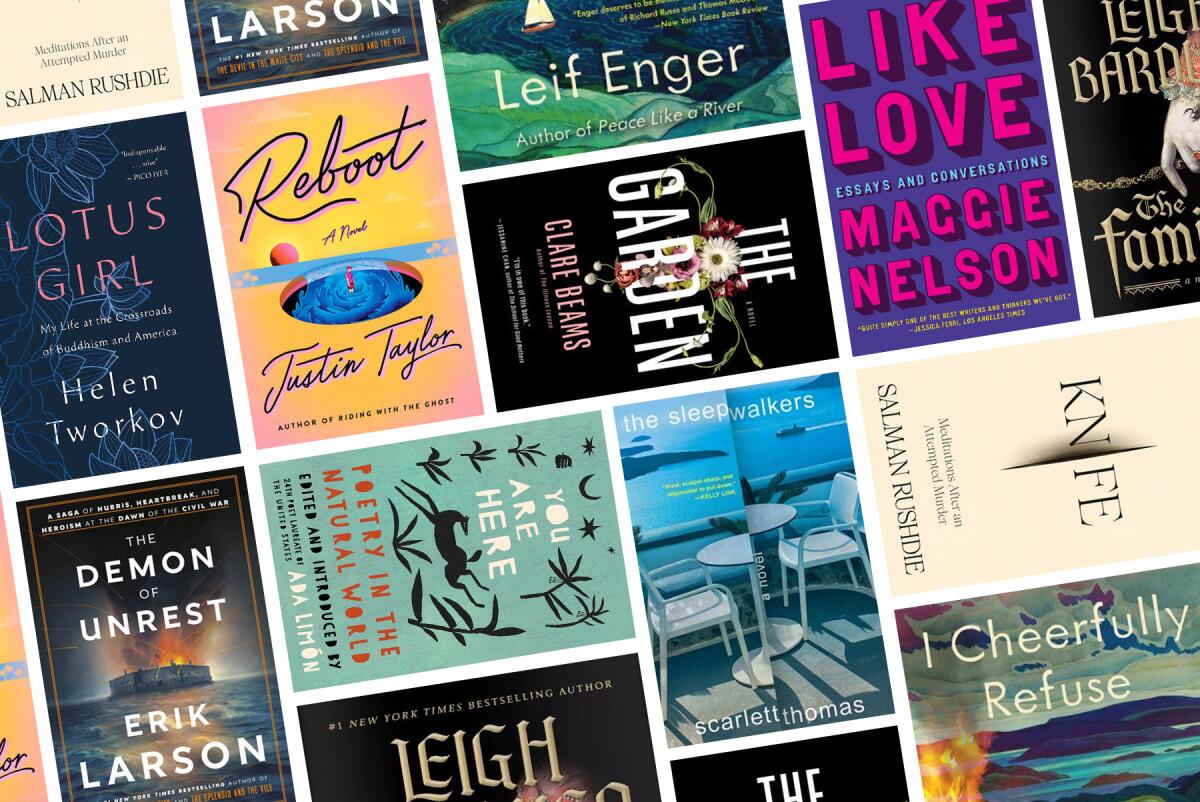
- Show more sharing options
- Copy Link URL Copied!
Critic Bethanne Patrick recommends 10 promising titles, fiction and nonfiction, to consider for your April reading list.
April’s book releases cover some difficult topics, including Salman Rushdie discussing his 2022 maiming, Leigh Bardugo’s fiction about the dark arts and Ada Limón’s poetry anthology about our fragile world. However, like April, there is also sunshine: Leif Enger’s wild Great Lakes love story, Helen Tworkov’s beautiful memoir of Buddhism and a collection of the inimitable Maggie Nelson’s essays. Happy reading, happy spring!
I Cheerfully Refuse: A Novel By Leif Enger Grove Press: 336 pages, $28 (April 2)

An unusual and meaningful surprise awaits readers of Enger’s latest, which takes place largely on Lake Superior, as a man named Rainy tries to reunite with his beloved wife, Lark. While the world around this couple, a dystopian near-future American where billionaires control everything, could not be bleaker, the author’s retelling of the myth of Orpheus (who went to the underworld to rescue his wife) contains the authentic hope of a born optimist.
The Familiar: A Novel By Leigh Bardugo Flatiron Books: 400 pages, $30 (April 9)
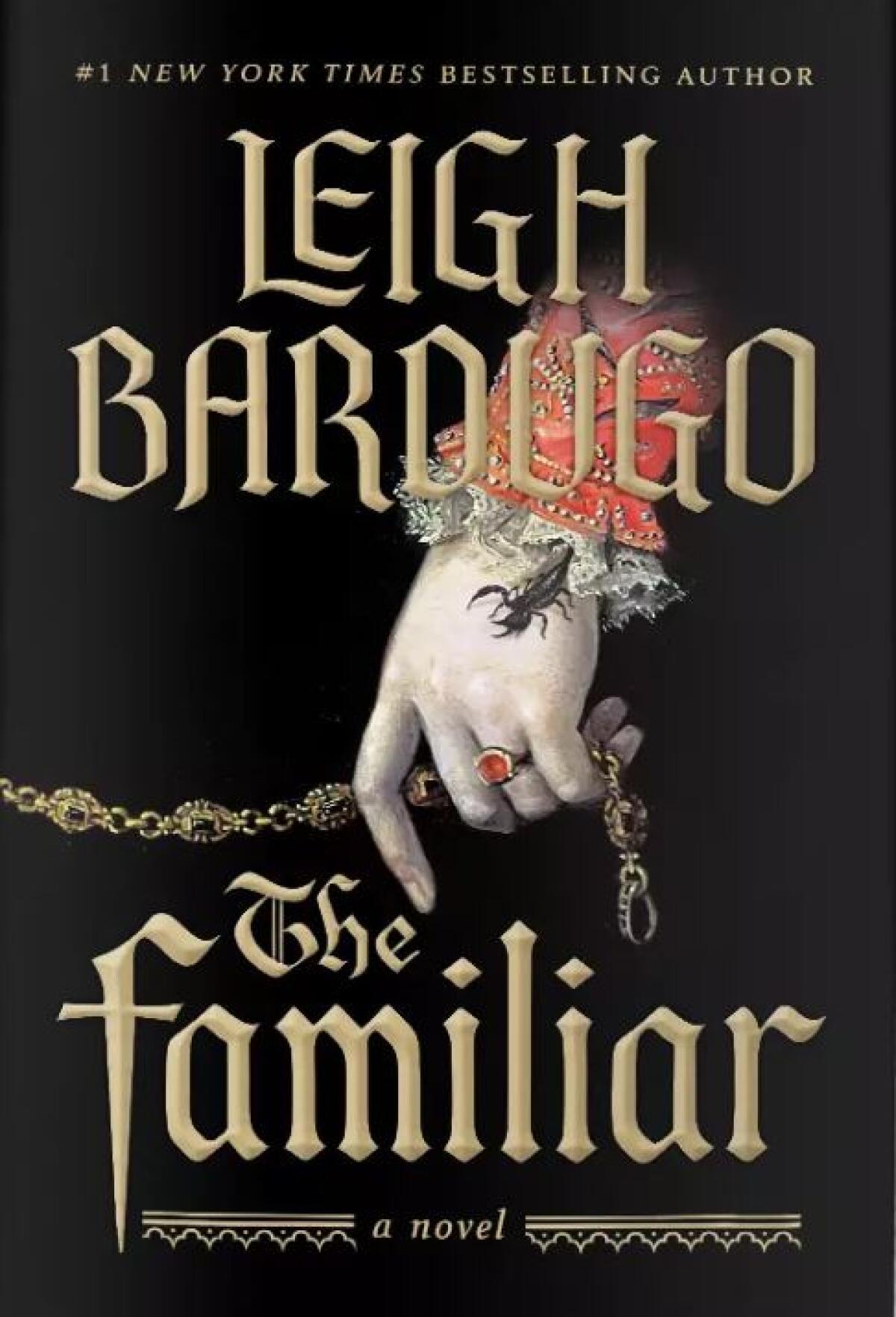
Bardugo departs from novels of dark academia in a standalone to make the hairs on your neck stand up, set in 16th century Spain. A hidden Sephardic Jew and scullery maid named Luzia Cotado matches wits with fellow servant Guillén Santángel. Luzia discovers a secret of Guillén’s, but she’s already fallen in love with him. And because he knows hers, too, they might both avoid the Spanish Inquisition. It’s a gorgeous tale of enchantments both supernatural and earthly.
The Sleepwalkers: A Novel By Scarlett Thomas Simon & Schuster: 304 pages, $28 (April 9)

A couple honeymoons at a Greek resort. What could go wrong? In Thomas’ hands, plenty – especially as the author has never written a comfortable story; her books, from “PopCo ” to “Oligarchy,” crackle with unreliable characters, as well as big philosophical ideas. In this case, the new marriage’s breakdown is chronicled through letters between the spouses, and sometimes bits of ephemera, that ultimately untangle a dark mystery relating to the title.
The Garden: A Novel By Clare Beams Doubleday: 304 pages, $28 (April 10)

Few novels of literary fiction are written as well as “The Garden,” let alone given its sadly relevant retro setting, a 1940s country-estate obstetrical program. Irene Willard walks through its gates having endured five miscarriages; pregnant again, she and her war-veteran husband George desperately hope for a live birth. But as Irene discovers more about the woman who controls all here, Dr. Bishop, she fears carrying to term as much as she once feared pregnancy loss.
Reboot: A Novel By Justin Taylor Pantheon: 304 pages, $28 (April 23)
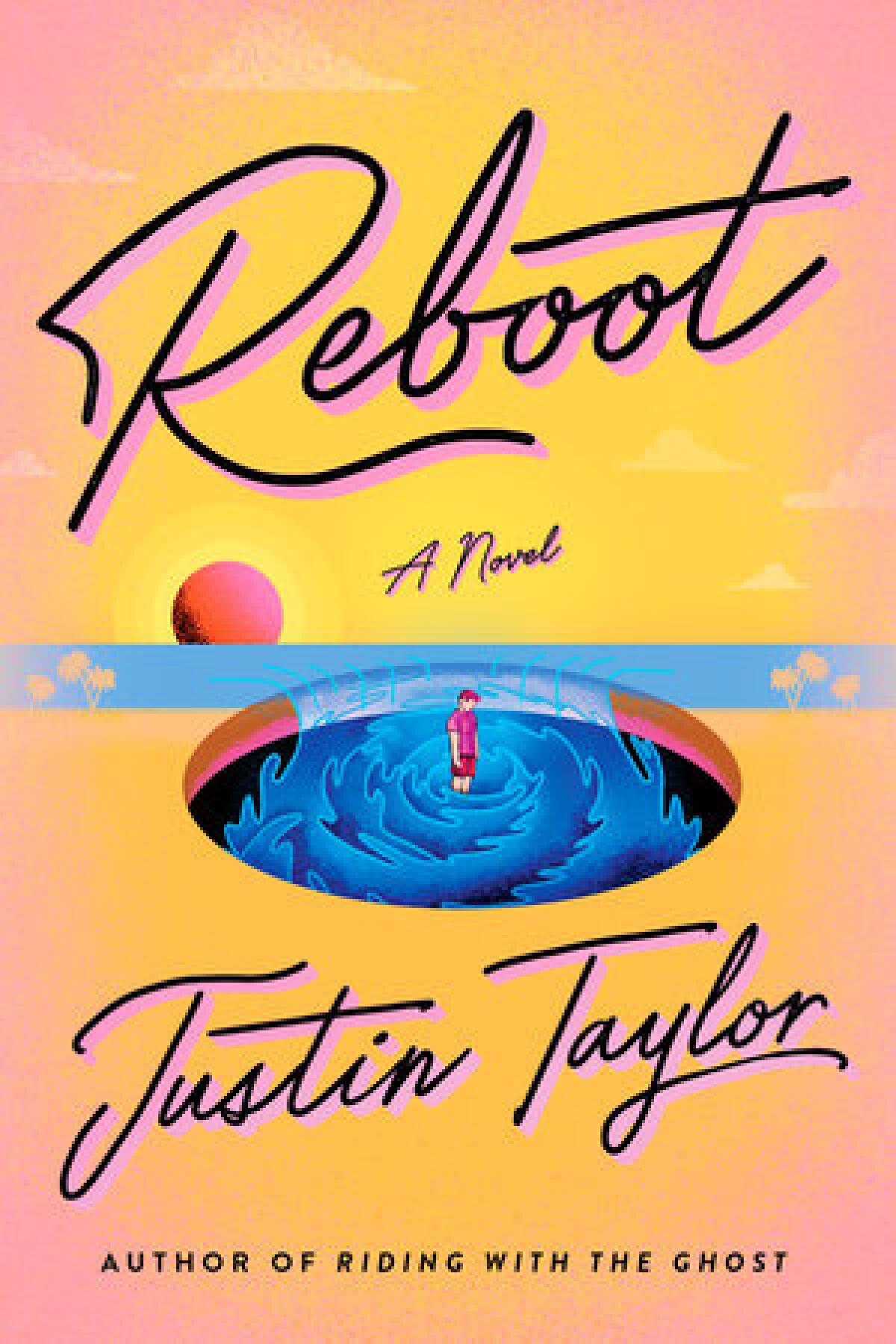
David Crader, former teen TV heartthrob, just wants to reboot his career when his old show “Rev Beach” has a moment. His life has devolved through substance abuse, divorce and underemployment. But when he and colleagues launch a remake, devolution continues: The protagonist’s struggles are mirrored by climate-change issues, from flooding to wildfires. Despite that darkness, Taylor’s gift for satire might make this a must-read for 2024 beach bags.
You Are Here: Poetry in the Natural World By Ada Limón (Editor) Milkweed Editions: 176 pages, $25 (April 2)

A wondrous artist herself, Limón is currently poet laureate of the United States, and this anthology is part of her signature project, “You Are Here,” which will also feature poetry as public art in seven national parks. Released in conjunction with the Library of Congress, the collection features 50 previously unpublished poems by luminaries including Jericho Brown, Joy Harjo, Carl Phillips and Diane Seuss, each focusing on a piece of regional landscape.
Like Love: Essays and Conversations By Maggie Nelson Graywolf Press: 336 pages, $32 (April 2)

While all of the pieces in Nelson’s new book have previously been published elsewhere, they’re made fresh here both through being collected and through their chronological placement. Readers can practically watch Nelson’s incisive mind growing and changing as she speaks with colleagues such as Hilton Als and Judith Butler, or as she writes about queerness, motherhood, violence, the lyrics of Prince and the devastating loss of a friend.
Knife: Meditations After an Attempted Murder By Salman Rushdie Random House: 204 pages, $28 (April 16)

On Aug. 12, 2022, the author Salman Rushdie was speaking at upstate New York’s Chautauqua festival when a man rushed the stage and attempted to murder him. Rushdie, a target of Iranian religious leaders since 1989, was permanently injured. In this book, he shares his experience for the first time, having said that this was essential for him to write. In this way, he answers violence with art, once again reminding us all that freedom of expression must be protected.
Lotus Girl: My Life at the Crossroads of Buddhism and America By Helen Tworkov St. Martin’s Essentials: 336 pages, $29 (April 16)
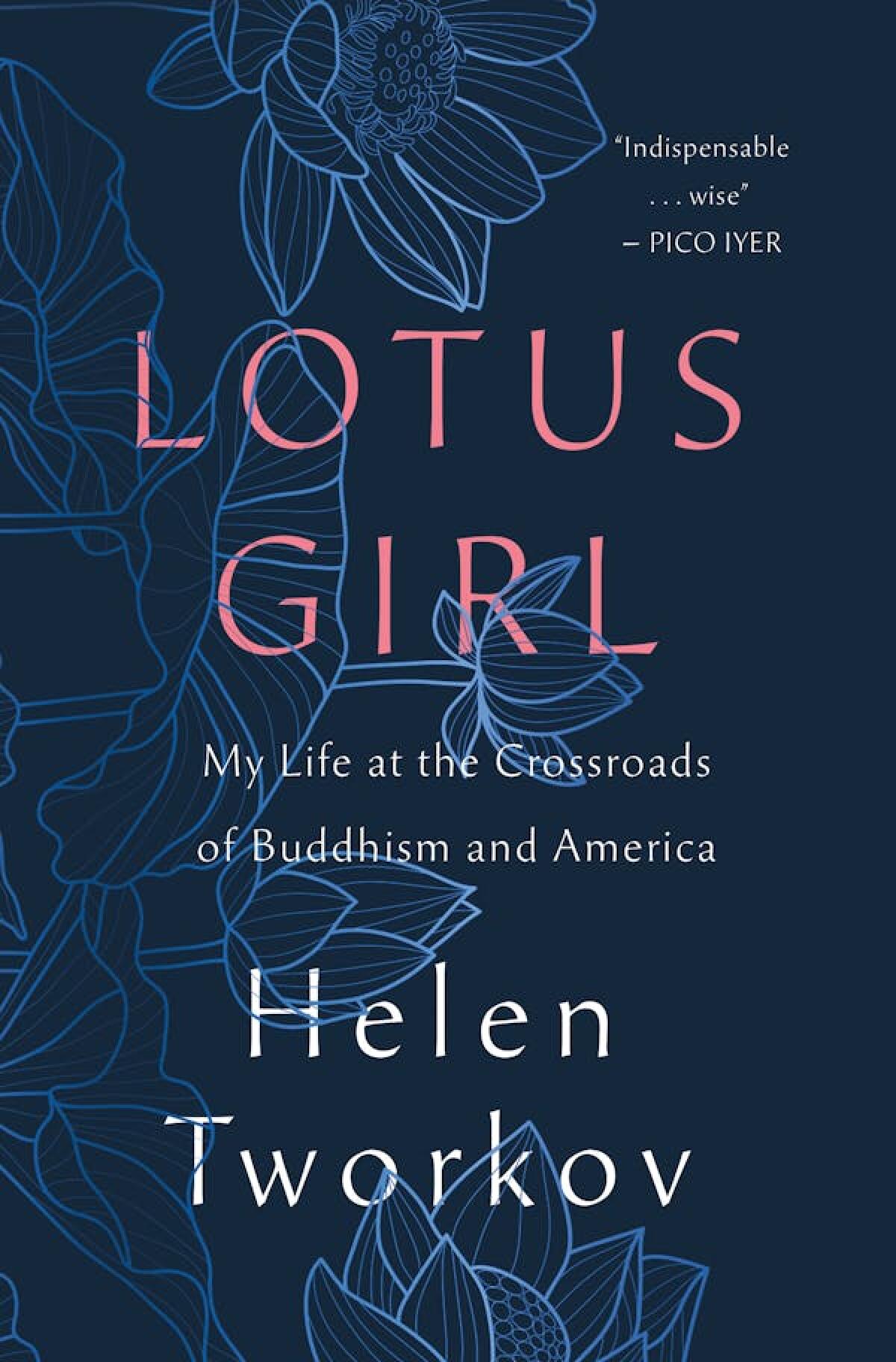
Tworkov, founder of the magazine Tricycle, chronicles her move from a 1960s young-adult interest in Buddhism to travels through Asia and deep study in the United States of the different strands that follow the Buddha’s teachings. Tworkov mentions luminaries such as the artist Richard Serra, the composer Charles Mingus and the Dalai Lama, but she’s not name-dropping. Instead, she’s strewing fragrant petals from her singular path to mindfulness that may help us find ours.
The Demon of Unrest: A Saga of Hubris, Heartbreak, and Heroism at the Dawn of the Civil War By Erik Larson Crown: 592 pages, $35 (April 30)

Even diehard Civil War aficionados will learn from Larson’s look at the six months between Lincoln’s 1860 election and the surrender of Union troops under Maj. Robert Anderson at Charleston’s Ft. Sumter. Larson details Anderson’s secret Christmas redeployment and explores this individual’s contradictions as a former slave owner who loyally follows Lincoln’s orders. The author also shares first-person perspective from the famous diaries of the upper-class Southerner Mary Chesnut. All together, the book provides a riveting reexamination of a nation in tumult.
More to Read

The week’s bestselling books, April 14
April 10, 2024
The week’s bestselling books, April 7
April 3, 2024

3 best mystery books to read this spring
A cure for the common opinion
Get thought-provoking perspectives with our weekly newsletter.
You may occasionally receive promotional content from the Los Angeles Times.
More From the Los Angeles Times

From Pomona to Oakland, how a skater mapped California block by block from his board
April 12, 2024

Lionel Shriver airs grievances by reimagining American society
April 8, 2024
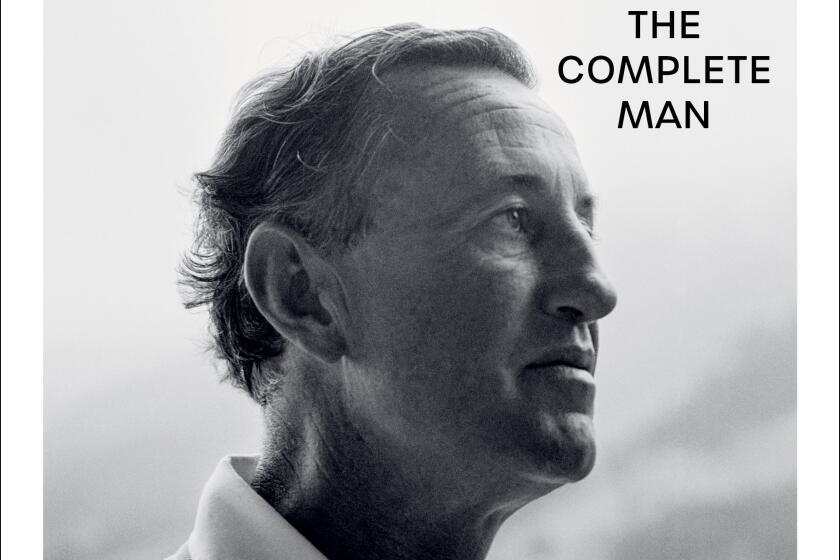
James Bond’s creator lived a life to rival the spy’s
April 4, 2024

How people of color carry the burden of untold stories
- Craft and Criticism
- Fiction and Poetry
- News and Culture
- Lit Hub Radio
- Reading Lists

- Literary Criticism
- Craft and Advice
- In Conversation
- On Translation
- Short Story
- From the Novel
- Bookstores and Libraries
- Film and TV
- Art and Photography
- Freeman’s
- The Virtual Book Channel
- Behind the Mic
- Beyond the Page
- The Cosmic Library
- The Critic and Her Publics
- Emergence Magazine
- Fiction/Non/Fiction
- First Draft: A Dialogue on Writing
- Future Fables
- The History of Literature
- I’m a Writer But
- Just the Right Book
- Lit Century
- The Literary Life with Mitchell Kaplan
- New Books Network
- Tor Presents: Voyage Into Genre
- Windham-Campbell Prizes Podcast
- Write-minded
- The Best of the Decade
- Best Reviewed Books
- BookMarks Daily Giveaway
- The Daily Thrill
- CrimeReads Daily Giveaway

What Should You Read Next? Here Are the Best Reviewed Books of the Week
Featuring new titles by leigh bardugo, alexandra fuller, anne lamott, and more.

Leigh Bardugo’s The Familiar , Alexandra Fuller’s Fi , and Anne Lamott’s Somehow all feature among the Best Reviewed Books of the Week.
Brought to you by Book Marks , Lit Hub’s home for book reviews.
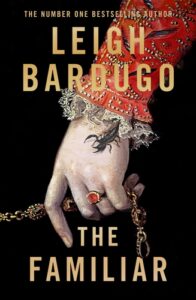
1. The Familiar by Leigh Bardugo (Flatiron)
“Bardugo brilliantly explores the wavy line between the supernatural and the divine … When Bardugo chooses to venture further into the darkness, it’s that much more devastating because of how much fun the reader has been having. In fact, she is a master of anticlimax: She builds apprehension for huge events that do not come to pass, then blindsides the reader with something totally unexpected instead … A thrilling addition to her canon about oppression and liberation, and anyone interested in this historical period and the themes she’s exploring will find it engrossing.”
–Charlie Jane Anders ( The Washington Post )
2. The Sleepwalkers by Scarlett Thomas (Simon & Schuster)
6 Rave • 1 Positive
“For Thomas, nothing seems to be off the table. She shifts between erotic thrills, gothic drama, postmodern deconstruction and kitchen-sink realism. Through her bold storytelling, The Sleepwalkers becomes a work of peculiar, gonzo genius … Thomas takes a glamorous late-capitalist setting, with rosé and catamarans, and shreds, twists and warps it into a story that is surprising, humane and political to its bones.”
–Flynn Berry ( The New York Times Book Review )
3. The Limits by Nell Freudenberger (Knopf)
2 Rave • 5 Positive Read an excerpt from The Limits here
“Freudenberger is fluent in every realm, social conundrum, and crime against the earth she brings into focus, keenly attuned to science and emotion, tradition and high-tech, race and gender, greed and conscience, irony and tragedy. Each character’s challenges are significant on scales intimate and global and their wrestling with secrets, anger, and fear grows increasingly suspenseful in this lambent, deeply sympathetic, and thought-provoking novel.”
–Donna Seaman ( Booklist )
1. Fi: A Memoir of My Son by Alexandra Fuller (Grove Press)
“Fuller leaves nothing under the table, under the rug or under wraps … The last thing you expect to do when you read a book about a child dying is to laugh … The wit in this memoir is soul-piercing … Fuller is sagacious and perspicacious. She is a sublime writer. In the hands of another memoirist, the story of Fi might be unbearably sad, but this book is a mesmeric celebration of a boy who died too soon, a mother’s love and her resilience. It will help others surviving loss—surviving life.”
–David Sheff ( The New York Times Book Review )
=2. The Wives: A Memoir by Simone Gorrindo (Gallery/Scout Press)
3 Rave • 2 Positive
“Gorrindo’s memoir is a gorgeously rendered peek behind the curtain of military life, as she recounts reckoning with her husband’s participation in violence—and examining why his job exists at all.”
–Courtney Eathorne ( Booklist )
=2. Somehow: Thoughts on Love by Anne Lamott (Riverhead)
3 Rave • 2 Positive Read an essay by Anne Lamott here
“In her trademark godly yet snarky way, she extracts every life lesson from her latest new experience with the deft zeal of a chef reducing flour and fat to roux … At times, Somehow made me huffy about—by which I mean envious of—Lamott’s gift for writing powerfully, deeply, often radically, while appealing to, well, everyone … No matter one’s external descriptors, Lamott speaks to the human in all of us, challenging us to bear her beam of love, and our own.”
–Meredith Maran ( The Washington Post )
- Share on Facebook (Opens in new window)
- Click to share on Twitter (Opens in new window)
- Click to share on Google+ (Opens in new window)
- Click to share on LinkedIn (Opens in new window)
- Click to share on Reddit (Opens in new window)
- Click to share on Tumblr (Opens in new window)
- Click to share on Pinterest (Opens in new window)
- Click to share on Pocket (Opens in new window)

Previous Article
Next article, support lit hub..

Join our community of readers.
to the Lithub Daily
Popular posts.

Follow us on Twitter

Lit Hub Daily: April 12, 2024
- RSS - Posts
Literary Hub
Created by Grove Atlantic and Electric Literature
Sign Up For Our Newsletters
How to Pitch Lit Hub
Advertisers: Contact Us
Privacy Policy
Support Lit Hub - Become A Member
Become a Lit Hub Supporting Member : Because Books Matter
For the past decade, Literary Hub has brought you the best of the book world for free—no paywall. But our future relies on you. In return for a donation, you’ll get an ad-free reading experience , exclusive editors’ picks, book giveaways, and our coveted Joan Didion Lit Hub tote bag . Most importantly, you’ll keep independent book coverage alive and thriving on the internet.

Become a member for as low as $5/month
Advertisement
Supported by
The Culture Warriors Are Coming for You Smart People
In Lionel Shriver’s new novel, judging intelligence and competence is a form of bigotry.
- Share full article

By Laura Miller
Laura Miller is a books and culture columnist for Slate and the author of “The Magician’s Book: A Skeptic’s Adventures in Narnia.”
MANIA , by Lionel Shriver
As a novelist, Lionel Shriver has made her strongest impressions selecting some hot issue of the day — school shootings, the American health care system, the ballooning of the U.S. national debt — and working it into a well-paced drama about its effects on one family. When this formula works, as it did best with “We Need to Talk About Kevin” (2003), the result can be riveting and also very popular. The intimacy of domestic politics moderates Shriver’s polemical side, which, when given free rein — as during an infamous 2016 speech she gave on cultural appropriation while wearing a sombrero — usually turns out to be smug, crude and obtuse.
In Shriver’s tiresome new novel, “Mania ,” the balance is off. “Mania” is the story of Pearson Converse, an untenured academic who lives with her tree-surgeon partner and three children in a Pennsylvania college town. Most of the novel takes place during an alternate version of the 2010s, when a social-justice fad has been ignited by a best-selling book titled “The Calumny of I.Q.: Why Discrimination Against ‘Dumb People’ Is the Last Great Civil Rights Fight.”
Pearson’s son gets sent home from school for using “the D-word,” now considered a slur. Lawn signs appear in the neighborhood announcing “We support cognitive neutrality.” Student “predators” haunt the literature course Pearson teaches at the local liberal arts college, hungrily searching for any slip-up suggesting that she thinks some people are smarter than others, so they can report her to the administration and get her sacked. Worst of all, Pearson’s best friend from girlhood, Emory Ruth, boosts her TV career by taping editorials endorsing the new ideology known as Mental Parity.
In real life, partisan rancor typically fuels culture-war initiatives like this; in Shriver’s imaginary America, it barely exists. The new ethos gets rapidly and improbably adopted by everybody in every walk of life, regardless of political affiliation. Mental Parity not only borrows from the left’s obsession with egalitarianism, safetyism and language hygiene but also draws on the right’s mistrust of expertise and credentialism; it could have bipartisan appeal if it weren’t so patently absurd.
Soon, Barack Obama is out of favor for being “outstandingly astute, eloquent and well informed,” and replaced by Joe Biden, who makes a point of installing a Treasury secretary who’s “not only an imbecile but an imbecile who was recognizably an imbecile — someone whose speech and affect were conspicuously vacuous.” Similar incompetents are ordered to take out Osama bin Laden, a failed mission that leaves him free to bomb the Smithsonian’s Air and Space Museum.
Pearson’s partner, Wade, is forced to hire an assistant who knows nothing about arboriculture and drops a branch on him. Because medical degrees are “now handed out as carelessly as shopping fliers,” a young surgeon botches the ankle surgery his injuries require. Then Wade nearly dies after untrained nurses administer the wrong medication and is saved only by a doctor in his 50s, a relic from the good old days who has the temerity to know what he’s doing.
It goes on and on. Cars blow up because they’re built by idiots. Shrewd consumers import their food from overseas to avoid poisoning from unsafe American goods. Any word or phrase ever used as a synonym for “intelligent” (“quick,” “deep”) or stupid (“meatball,” “simple,” “dense”) must be purged from daily usage even when denoting a different meaning. If you want to order a wooden board at a hardware store, you have to ask for one that’s “two inches fat.” Mensa is “the kind of cerebral-supremacist organization” deemed “the greatest threat to American civic order” by no less than the F.B.I. Most fantastically, a child protective services investigator arrives at Pearson’s home because her youngest child reported her mother describing her as less intelligent than her siblings. “Use of language of such a derogatory character with minors,” this pious emissary states, “is classified as child abuse” and “potentially grounds for removing a child to foster care.”
As parody goes, this is ham-fisted stuff. Ironically, “Mania” lacks the discernment required to make it work. Satire demands precision, and Shriver applies an ax to a job calling for a scalpel. Although Shriver has made writing unlikable protagonists into a sort of cottage industry, Pearson is something more, a preeningly self-righteous didact swathed in false modesty about her own supposedly mediocre brain. Like many of Shriver’s narrators, Pearson often speaks or narrates with the sort of affected, antiquated vocabulary of a stock character from a 1930s movie, the portly gentleman in a white three-piece suit, up to no good and puffing on a cigar, played by Sidney Greenstreet. She has an odd, unexplained penchant for alliteration: “At the antediluvian argot, I nearly dropped my mask of stony stoicism.” She is not so much unlikable as simply insufferable.
Pearson’s past as an apostate of the Jehovah’s Witnesses makes her the sworn enemy of cant, and the only language she speaks is invective, so inevitably, she runs ruinously afoul of the new dispensation. Meanwhile, Emory’s star rises. She proves herself the ideal apparatchik on camera while privately snickering with Pearson and Wade over the silliness of Mental Parity, at least at first. The most — really the only — intriguing aspect of the novel is the relationship between these two friends and Pearson’s growing realization that Emory lacks a moral center. Emory herself remains a cipher. Is she a sociopath? Or just an opportunist? If only she were the unlikable narrator to tell this story. That would constitute a stretch for Shriver, imagining the interiority of a character who’s not basically an avatar of herself. That would be a truly daring choice, and dare I say it, a smart one.
MANIA | By Lionel Shriver | Harper | 277 pp. | $30
Explore More in Books
Want to know about the best books to read and the latest news start here..
Stephen King, who has dominated horror fiction for decades , published his first novel, “Carrie,” in 1974. Margaret Atwood explains the book’s enduring appeal .
The actress Rebel Wilson, known for roles in the “Pitch Perfect” movies, gets vulnerable about her weight loss, sexuality and money in her new memoir.
“City in Ruins” is the third novel in Don Winslow’s Danny Ryan trilogy and, he says, his last book. He’s retiring in part to invest more time into political activism .
Jonathan Haidt, the social psychologist and author of “The Anxious Generation,” is “wildly optimistic” about Gen Z. Here’s why .
Do you want to be a better reader? Here’s some helpful advice to show you how to get the most out of your literary endeavor .
Each week, top authors and critics join the Book Review’s podcast to talk about the latest news in the literary world. Listen here .
Leigh Bardugo’s latest is a magical tale based in real Spanish history
In her new novel, ‘the familiar,’ the author of the grishaverse series has crafted an essential read about oppression and liberation.

Leigh Bardugo has made a career out of writing about oppressed people who wield uncanny powers. Those concerns loom large in her young-adult Grishaverse series, about a downtrodden minority who command a world-shaping magic, and the hero of her adult debut, “ Ninth House ,” is also lifted up from poverty thanks to unique abilities. But her latest adult novel, “ The Familiar ,” explores this theme with an even greater depth and sensitivity.
“The Familiar,” which is set in late-16th-century Spain, is centered on a young servant named Luzia who has the power to create milagritos, or small miracles. When Luzia’s power is accidentally discovered, influential people want to use her for their own advancement, and soon she’s entangled in political intrigue, as well as competition with other miracle-workers. Through it all, Luzia must hide the true nature of her power, which comes from reciting refranes, or old sayings, in Ladino — a Sephardic dialect of Spanish mixed with Hebrew and other languages. Nobody can know that Luzia is a conversa, a Jew whose family was forced to convert to Catholicism.
Stories about subaltern people who can work wonders often serve as a way to think about the multifaceted nature of power — how total agency in one realm can give way to helplessness in others. But they are also a window into the dual nature of stigma, which often assigns improbable power and usefulness to the most-stigmatized people. This common fantasy trope — see these five recent novels about powerful underdogs — allows us to have it both ways, rooting for a hero who is an underdog but also unbeatable.
And yet “The Familiar” feels distinct from similar tales — including Bardugo’s own — because it explores a brutal and shameful real-life history. Bardugo unsparingly depicts the violence inflicted on Jews and other non-Christians by the Spanish Inquisition, and the toll that hiding imposes on people. “The Familiar” hits hardest when it shows Luzia’s father succumbing to madness, and her constant fear that she will be found out as a conversa. Bardugo brilliantly explores the wavy line between the supernatural and the divine: Magic is forbidden, but miracles come from God.
Luzia’s status as a scullion, or kitchen servant, also shapes how she moves through the world. She pretends to be illiterate, when in fact she can read Latin as well as Spanish, and puts on an exaggerated humble persona. She quickly befriends Santángel, the mysterious supernatural bodyguard to a powerful nobleman who is the familiar of the book’s title.
At one point, Santángel warns Luzia that her lowly-servant act has gotten so good that she risks believing in it: “I know what it is to lower yourself, to keep your eyes downcast, to seek invisibility. It is a danger to become nothing. You hope no one will look, and so one day when you go to find yourself, only dust remains, ground down to nothing from sheer neglect.” These words fuel Luzia’s hunger to show the world who she really is, despite the cost.
At times, the two halves of “The Familiar” are in an uneasy tension: Its escapist narrative about a lowly person whose power raises them up chafes against the much darker real-life story of the hateful Spanish Inquisition. Bardugo has clearly done a lot of research, but she uses it sparingly, and her breakneck pace sometimes means sacrificing immersion. Some of the political wranglings fail to fully come into focus, and one major development falls a bit flat as a result. (I couldn’t help contrasting it with Anne Rice’s historical fiction, which takes its time and shows every nook and cranny.) And yet, when Bardugo chooses to venture further into the darkness, it’s that much more devastating because of how much fun the reader has been having. In fact, she is a master of anticlimax: She builds apprehension for huge events that do not come to pass, then blindsides the reader with something totally unexpected instead.
“The Familiar” is strongest when it pulls back from Luzia’s perspective and becomes more of an ensemble novel. Luzia’s aunt Hualit, who has successfully hidden her Jewish origins and become a glamorous mistress to Santángel’s patron, has a fascinating arc. And Luzia’s former employer, Valentina, finds herself reevaluating her whole life. These smaller stories add considerable weight to the heroic journey of Luzia and Santángel.
Fans of Bardugo’s work will find “The Familiar” a thrilling addition to her canon about oppression and liberation, and anyone interested in this historical period and the themes she’s exploring will find it engrossing. This is a story about the suffering that results when the majority imposes its religion on everyone else, using coercive authority to control the identities of all. That, alone, makes “The Familiar” an essential read.
Charlie Jane Anders is the author of “Promises Stronger Than Darkness,” the final book in a young-adult trilogy that began with “Victories Greater Than Death.” Her other books include “The City in the Middle of the Night” and “All the Birds in the Sky.” She has won the Hugo, Nebula, Sturgeon, Lambda Literary, Crawford and Locus awards.
The Familiar
By Leigh Bardugo
Flatiron. 385 pp. $29.99
We are a participant in the Amazon Services LLC Associates Program, an affiliate advertising program designed to provide a means for us to earn fees by linking to Amazon.com and affiliated sites.


IMAGES
VIDEO
COMMENTS
Be succinct, but give enough to serve the purpose of the review. Points to Consider: What if you really don't like the book? Always write your reviews with integrity. If you honestly don't like a book, write your review as if you are in a critique session with the author. Use positive words and avoid sarcasm.
A great example of this is fellow nonfiction book blogger Paula Ghete 's book reviews such as this one of Cosmos by Carl Sagan ( which you can compare to mine to see how greatly our styles vary). Her book reviews are structured this way: 10-Word Summary: We can understand the Universe only if we study it.
Method 3: Use a Classic Structure. The third approach you can take to structuring your book is to choose a classic structure. By classic, I mean that there are classic outlines that have stood the test of time. Let me give you a few examples.
This structure begins by identifying and thoroughly exploring a problem, setting the stage for the book's primary focus. In this phase, you'll delve into the nuances of the issue, often incorporating statistics, anecdotes, and historical context to give the reader a comprehensive understanding of the problem's significance and impact.
If You Decline. Give the author a thoughtful and honest response. Say you appreciate the honor of being considered to write a nonfiction book review, and explain why you have to give his or her project a pass. Wish the author the best of success in the project. Pat Iyer loves it when she gets reviews of her books on Amazon.
Since there aren't many works of fiction about retrocomputing, the book reviews I publish are generally of non-fiction. The first draft of those reviews often read something like this: In the first chapter, the author covers this period of retrocomputing. In the second chapter, she moves on to these other topics.
Personal Book Review Structure: There's a lot of wiggle room when it comes to learning how to write a book review for your blog, friends, or just to post on the book's sales page online. ... Book Review Example 4 - Nonfiction Amazon Review. Nonfiction books typically serve a specific purpose. They're teaching, informing, arguing, or ...
Be sure to mention the authors of the title and what experience or expertise they bring to the title. Check Stefan Kløvning's review of Creativity Cycling for an example of a summary that establishes the framework of the book within the context of its field. Step 2. Present your evaluation.
Hold onto that book idea of yours, and let's see how we can turn it into something that readers will love. How to write a nonfiction book: 1. Determine what problem your book will solve. 2. Outline your book with a logical structure. 3. Choose a style guide to remain consistent. 4.
The opening should immediately grab the reader's attention and set the stage for your review. Most of the time, writing a book review has the following parts: Information about the book: Give the title, author's name, release date, and subject as your first information. This helps people know which book you are talking about.
Blog - Posted on Thursday, Nov 11 The Only Book Review Templates You'll Ever Need Whether you're trying to become a book reviewer, writing a book report for school, or analyzing a book, it's nice to follow a book review template to make sure that your thoughts are clearly presented.. A quality template provides guidance to keep your mind sharp and your thoughts organized so that you can ...
Book review examples for non-fiction books Nonfiction books are generally written to inform readers about a certain topic. As such, the focus of a nonfiction book review will be on the clarity and effectiveness of this communication. In carrying this out, a book review may analyze the author's source materials and assess the thesis in order ...
How to Follow the 7 Step Structure. Fill out notes for each of the seven sections. Where you'll start, what your reader will learn, and any action steps for your reader. When you get to the body of your book, organize the chapters by theme or progressive steps. Make notes about the content of each chapter.
Outline the three parts of your story to lay the plan for your nonfiction book. Obviously, all stories have a beginning, middle, and end, but the three parts I suggest you consider are these: What it used to be like. What happened. What it's like now. Start with what life was like before the change happened.
Step 2: Structure your book to best address the main problem. Now's the time to organize all your thoughts and create a rough skeleton of your book. You'll need to arrange your knowledge into a logical string of thoughts that will best help readers find the answer to your question.
Pay attention to the author's arguments, evidence, and the overall structure of the book. Take note of any biases or assumptions and evaluate the book's credibility and reliability. 3. Provide a Brief Summary. Begin your review by providing a concise summary of the book's main points and arguments.
Step 1: Planning. Create an essay outline which includes all of the main points you wish to summarise in your book analysis. Include information about the characters, details of the plot, and some other important parts of your chosen novel. Reserve a body paragraph for each point you wish to talk about.
Structure And Organize Your Non-Fiction Book. "Non-fiction requires enormous discipline. You construct the terms of your story, and then you stick to them.". Barbara Kingsolver. Although non-fiction books don't contain the classic narrative arc of novels, they still need to take the reader on a journey of understanding.
Using the post it notes you rearranged earlier, you should now see the basis of your outline. Remember to include a short introduction, then divide the book into sections, then headings, then subheadings. It's OK if you're not 100% sure of the chapters and their exact order. You can only plan so much and a lot of the answers you're ...
How to Write a Nonfiction Book in 21 Steps. #1— Develop the mindset to learn how to write a nonfiction book. #2 - Create a Book Writing Plan. #3 - Identify your WHY. #4 - Research nonfiction book topics. #5 - Select a nonfiction book topic. #6 — Drill down into your book idea. #7 — Schedule writing time. #8 — Establish a writing ...
Structure is a critical component of non-fiction writing. A well-structured piece of non-fiction is easier to read and understand. It also helps the writer to present their ideas in a logical and coherent manner. A structured approach to non-fiction writing involves breaking down the work into smaller sections, each with its own focus and purpose.
But here is some of the format used by many great writers which you can use in your nonfiction book. 1. Table Of Contents. One of the best way to structure a nonfiction book is by creating a table of content and outlining everything even before you start writing your first chapter.
Use this lovely book review template to inspire your children to reflect on the non-fiction books they have read. With sections including illustrating the front cover, sharing their favorite fact and noting down new vocabulary and their meaning, this worksheet is a great way to scaffold children's thoughts about a variety of non-fiction texts. This sheet is perfect for an independent ...
Critic Bethanne Patrick recommends 10 promising titles, fiction and nonfiction, to consider for your April reading list. April's book releases cover some difficult topics, including Salman ...
Leigh Bardugo's The Familiar, Alexandra Fuller's Fi, and Anne Lamott's Somehow all feature among the Best Reviewed Books of the Week. Brought to you by Book Marks, Lit Hub's home for book reviews. * Fiction. 1. The Familiar by Leigh Bardugo (Flatiron) 8 Rave "Bardugo brilliantly explores the wavy line between the supernatural and the ...
Want to know about the best books to read and the latest news? Start here. Stephen King, who has dominated horror fiction for decades , published his first novel, "Carrie," in 1974.
Amid a surge in book bans, the most challenged books in the United States in 2023 continued to focus on the experiences of L.G.B.T.Q. people or explore themes of race.
Check out the complete lists of 50 notable works for fiction and the top 50 nonfiction books of last year. ... You can also check out reviews of the latest in fiction and nonfiction. Share ...
Super readers share their tips on how to finish more books. Or let poet and essayist Hanif Abdurraqib explain why he stays in Ohio. You can also check out reviews of the latest in fiction and ...
Books Book Reviews Fiction Nonfiction April books 50 notable fiction books. Leigh Bardugo's latest is a magical tale based in real Spanish history. In her new novel, 'The Familiar,' the ...